Paul van Yperen's Blog, page 221
September 23, 2019
Jenny (1958)
The romantic comedy Jenny (1958) was the first Dutch film in colour. The film was directed by Willy van Hemert and his daughter Ellen played the title role. At the same time a German language version of Jenny was directed by Alfred Bittins, which featured Gisela Fritsch and was released a year later. The Dutch version was a popular success, but Van Hemert would never direct another feature film again.
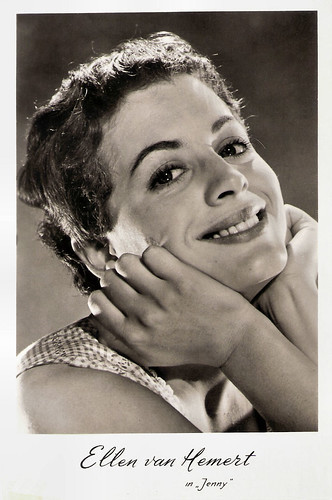
Dutch postcard by Uitg. Takken, Utrecht, no. 3195. Photo: N.V. Standaardfilms. Ellen van Hemert in Jenny (Willy van Hemert, 1958).
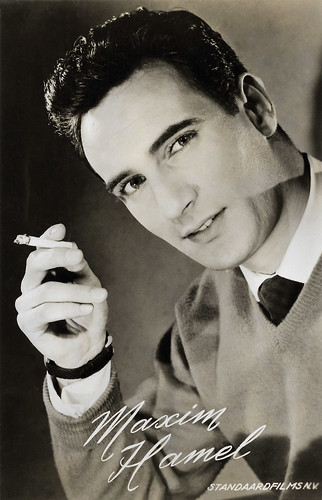
Dutch postcard by Uitg. Takken, Utrecht, no. 3750. Photo: N.V. Standaardfilms. Maxim Hamel in Jenny (Willy van Hemert, 1958).
Getting pregnant while training for a rowing contest
Jenny (Willy van Hemert, 1958) is a remake of the German film Acht Mädels Im Boot/Eight Girls in a Boat (Erich Waschneck, 1932) with Karin Hardt.
The 1958 version, Jenny, was a Dutch/German co-production and an alternate language version was being shot at the same time with German actors. The German version of Jenny was co-directed by Alfred Bittins, featured Gisela Fritsch and was released a year later.
Willy van Hemert asked his daughter Ellen for the title role in the Dutch version. Ellen van Hemert plays the 18 year old Jenny who gets pregnant during her busy training schedule for a rowing contest. Her boyfriend Ed (Maxim Hamel) fancies himself rather a swinging jet-setter and is therefore quite unprepared for fatherhood. He leaves her. She must make a difficult decision, but everything comes to good ends.
Handsome Maxim Hamel was one the few Dutch film stars of the 1950s and 1960s. He also played the German version, Jenny (Alfred Bittins, Willy van Hemert, 1959) with Gisela Fritsch. Later,Van Hemert also directed him in the TV films Claudia (Willy van Hemert, 1959) with Kitty Janssen, and Marguerite Gautier (Willy van Hemert, 1963) as Armand Duval opposite Andrea Domburg .
The cast also featured well known Dutch film actors like Kees Brusse and Andrea Domburg , as well as the orchestra of Max Woiski and popular Dutch singer Corry Brokken . Brokken sang the song Weet je nog? (Do you remember?) by Willy van Hemert and Jos Cleber in the film.
In 1956 Corry Brokken represented the Netherlands for the first time at the Eurovision Song Contest. Her song Voorgoed Voorbij (Over For Good) did not win. That year the results of the jury were secret; only the winner was announced.
The following year she won the Eurovision Song Contest with the song Net als Toen (Like It Used To Be), which was also composed by Willy van Hemer). And in 1958 she represented the Netherlands again with Heel de Wereld (The Whole World), but this time she came no further than a shared last - 9th - place with Luxembourg.
As noted by author and historian John Kennedy O'Connor in his book 'The Eurovision Song Contest - The Official History', Corry is the only singer ever to have finished both first and last in the contest. Jenny was her only film.
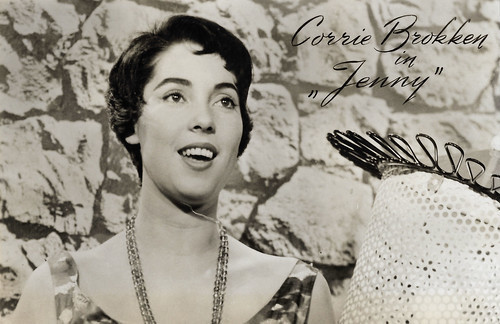
Dutch postcard by Uitg. Takken, Utrecht, no. 3540. Photo: N.V. Standaardfilms / Hajo Spörr. Corry Brokken in Jenny (Willy van Hemert, 1958).
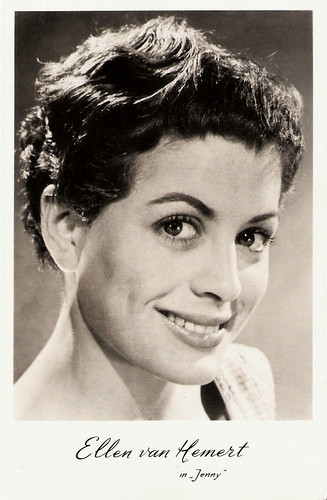
Dutch postcard by Uitg. Takken, Utrecht, no. 3191. Photo: N.V. Standaardfilms. Ellen van Hemert in Jenny (Willy van Hemert, 1958).
Why no follow-up?
Jenny (Willy van Hemert, 1958) attracted more than half a million visitors (569,043 visitors in total). However, both Willy van Hemert and his daughter Ellen never made another film. Ellen only made some television films in the early 1960s and worked on stage. Why was there no follow-up despite the film's box office success?
Is Jenny a bad film? Chip Douglas at IMDb : "Critics weren't kind to Jenny, saying that the Dutch films in general couldn't compete with Bert Haanstra's documentary features that were all the rage at the time."
And yes, the German script is indeed poor, but Jenny is as throughly Dutch as Haanstra's films are. It contains beautiful images of the bridges and canal houses of Amsterdam, of the Bosbaan where the rowing contest is situated and the Amstel river. Van Hemert introduced the colour in the film in an original way, by letting Jenny row under a bridge in black and white and let her row away in colour.
On 2 October 1951, Willy van Hemert had directed and written the very first television drama broadcast in the Netherlands: De toverspiegel/The Magic Mirror (1951). He wanted to move to the cinema and saw Jenny as a stepping stone to get over with so he could go on to do his own projects. Unfortunately for him, his production partner Jan Kemps died shortly after both Jenny's were completed and this never happened.
Van Hemert subsequently returned to television. In the following decades he became one of the most renowned Dutch directors of television drama and made such popular Dutch TV series as De Kleine Waarheid/The little truth (1970-1972) with Willeke Alberti , Bartje (1972-1973), and Dagboek van een Herdershond/Diary of a Shepherd Dog (1978-1980). He never got to helm another feature film though, but his son Ruud van Hemert later would make up for him and directed such popular film comedies as Schatjes/Army Brats (1984) and Mama is boos/Hitting the Fan! (1986).
The Netherlands Film Museum (now Eye) decided to preserve Jenny in 2001, because the original colours threatened to discolour. This version premiered in February 2002 and won a prize. In 2007 the film was released on DVD, in a limited edition.
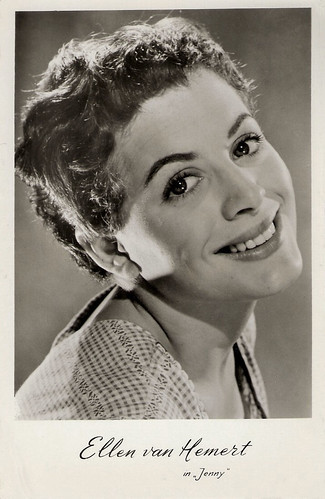
Dutch postcard by Uitg. Takken, Utrecht, no. 3190. Photo: N.V. Standaardfilms. Ellen van Hemert in Jenny (Willy van Hemert, 1958).
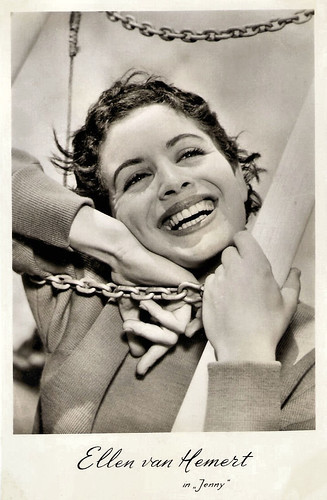
Dutch postcard by Uitg. Takken, Utrecht, no. 3192. Photo: N.V. Standaardfilms. Ellen van Hemert in Jenny (Willy van Hemert, 1958).
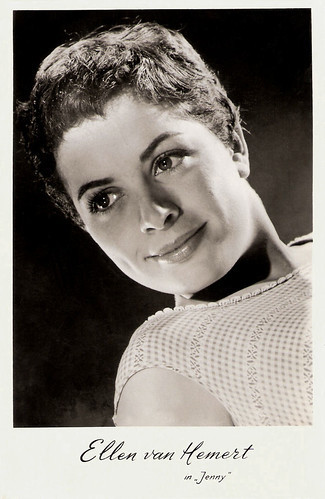
Dutch postcard by Uitg. Takken, Utrecht, no. 3194. Photo: N.V. Standaardfilms. Ellen van Hemert in Jenny (Willy van Hemert, 1958).
Eye uploaded the full restored version of Jenny on YouTube. Enjoy!
The Netherlands Film Festival (NFF) starts next week. From 27 September till 5 October, Utrecht will once again be the capital of the Dutch cinema. During the festival, EFSP will provide you daily with postcards of Dutch films and stars. So check out our Unofficial Dutch Film Star Postcards Festival!
Sources: Chip Douglas (IMDb), MovieMeter (Dutch), Wikipedia (English and Dutch) and IMDb.

Dutch postcard by Uitg. Takken, Utrecht, no. 3195. Photo: N.V. Standaardfilms. Ellen van Hemert in Jenny (Willy van Hemert, 1958).

Dutch postcard by Uitg. Takken, Utrecht, no. 3750. Photo: N.V. Standaardfilms. Maxim Hamel in Jenny (Willy van Hemert, 1958).
Getting pregnant while training for a rowing contest
Jenny (Willy van Hemert, 1958) is a remake of the German film Acht Mädels Im Boot/Eight Girls in a Boat (Erich Waschneck, 1932) with Karin Hardt.
The 1958 version, Jenny, was a Dutch/German co-production and an alternate language version was being shot at the same time with German actors. The German version of Jenny was co-directed by Alfred Bittins, featured Gisela Fritsch and was released a year later.
Willy van Hemert asked his daughter Ellen for the title role in the Dutch version. Ellen van Hemert plays the 18 year old Jenny who gets pregnant during her busy training schedule for a rowing contest. Her boyfriend Ed (Maxim Hamel) fancies himself rather a swinging jet-setter and is therefore quite unprepared for fatherhood. He leaves her. She must make a difficult decision, but everything comes to good ends.
Handsome Maxim Hamel was one the few Dutch film stars of the 1950s and 1960s. He also played the German version, Jenny (Alfred Bittins, Willy van Hemert, 1959) with Gisela Fritsch. Later,Van Hemert also directed him in the TV films Claudia (Willy van Hemert, 1959) with Kitty Janssen, and Marguerite Gautier (Willy van Hemert, 1963) as Armand Duval opposite Andrea Domburg .
The cast also featured well known Dutch film actors like Kees Brusse and Andrea Domburg , as well as the orchestra of Max Woiski and popular Dutch singer Corry Brokken . Brokken sang the song Weet je nog? (Do you remember?) by Willy van Hemert and Jos Cleber in the film.
In 1956 Corry Brokken represented the Netherlands for the first time at the Eurovision Song Contest. Her song Voorgoed Voorbij (Over For Good) did not win. That year the results of the jury were secret; only the winner was announced.
The following year she won the Eurovision Song Contest with the song Net als Toen (Like It Used To Be), which was also composed by Willy van Hemer). And in 1958 she represented the Netherlands again with Heel de Wereld (The Whole World), but this time she came no further than a shared last - 9th - place with Luxembourg.
As noted by author and historian John Kennedy O'Connor in his book 'The Eurovision Song Contest - The Official History', Corry is the only singer ever to have finished both first and last in the contest. Jenny was her only film.

Dutch postcard by Uitg. Takken, Utrecht, no. 3540. Photo: N.V. Standaardfilms / Hajo Spörr. Corry Brokken in Jenny (Willy van Hemert, 1958).

Dutch postcard by Uitg. Takken, Utrecht, no. 3191. Photo: N.V. Standaardfilms. Ellen van Hemert in Jenny (Willy van Hemert, 1958).
Why no follow-up?
Jenny (Willy van Hemert, 1958) attracted more than half a million visitors (569,043 visitors in total). However, both Willy van Hemert and his daughter Ellen never made another film. Ellen only made some television films in the early 1960s and worked on stage. Why was there no follow-up despite the film's box office success?
Is Jenny a bad film? Chip Douglas at IMDb : "Critics weren't kind to Jenny, saying that the Dutch films in general couldn't compete with Bert Haanstra's documentary features that were all the rage at the time."
And yes, the German script is indeed poor, but Jenny is as throughly Dutch as Haanstra's films are. It contains beautiful images of the bridges and canal houses of Amsterdam, of the Bosbaan where the rowing contest is situated and the Amstel river. Van Hemert introduced the colour in the film in an original way, by letting Jenny row under a bridge in black and white and let her row away in colour.
On 2 October 1951, Willy van Hemert had directed and written the very first television drama broadcast in the Netherlands: De toverspiegel/The Magic Mirror (1951). He wanted to move to the cinema and saw Jenny as a stepping stone to get over with so he could go on to do his own projects. Unfortunately for him, his production partner Jan Kemps died shortly after both Jenny's were completed and this never happened.
Van Hemert subsequently returned to television. In the following decades he became one of the most renowned Dutch directors of television drama and made such popular Dutch TV series as De Kleine Waarheid/The little truth (1970-1972) with Willeke Alberti , Bartje (1972-1973), and Dagboek van een Herdershond/Diary of a Shepherd Dog (1978-1980). He never got to helm another feature film though, but his son Ruud van Hemert later would make up for him and directed such popular film comedies as Schatjes/Army Brats (1984) and Mama is boos/Hitting the Fan! (1986).
The Netherlands Film Museum (now Eye) decided to preserve Jenny in 2001, because the original colours threatened to discolour. This version premiered in February 2002 and won a prize. In 2007 the film was released on DVD, in a limited edition.

Dutch postcard by Uitg. Takken, Utrecht, no. 3190. Photo: N.V. Standaardfilms. Ellen van Hemert in Jenny (Willy van Hemert, 1958).

Dutch postcard by Uitg. Takken, Utrecht, no. 3192. Photo: N.V. Standaardfilms. Ellen van Hemert in Jenny (Willy van Hemert, 1958).

Dutch postcard by Uitg. Takken, Utrecht, no. 3194. Photo: N.V. Standaardfilms. Ellen van Hemert in Jenny (Willy van Hemert, 1958).
Eye uploaded the full restored version of Jenny on YouTube. Enjoy!
The Netherlands Film Festival (NFF) starts next week. From 27 September till 5 October, Utrecht will once again be the capital of the Dutch cinema. During the festival, EFSP will provide you daily with postcards of Dutch films and stars. So check out our Unofficial Dutch Film Star Postcards Festival!
Sources: Chip Douglas (IMDb), MovieMeter (Dutch), Wikipedia (English and Dutch) and IMDb.
Published on September 23, 2019 22:00
September 22, 2019
Agnes Ayres
Agnes Ayres (1898-1940) was an American silent film actress. After her debut with Chaplin at Essanay and acting for Fox, Ayres had her breakthrough as Lady Diana Mayo in The Sheik (1921) featuring Rudolph Valentino. Important parts for Cecil B. DeMille at Paramount followed such as in The Affairs of Anatol (1921) and the epic The Ten Commandments (1923). After a dip in the mid-1920s, she made a comeback in The Son of the Sheik (1926), but the arrival of sound cinema finished her career.
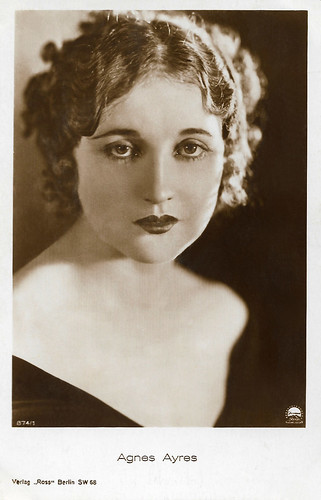
German postcard by Ross Verlag, no. 874/1. Photo: Paramount.
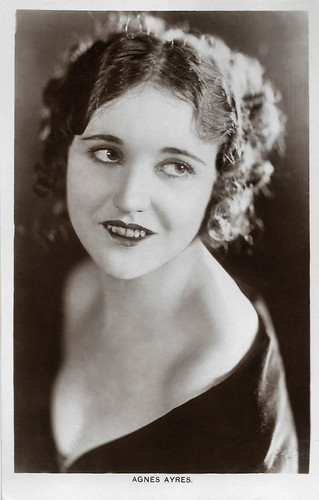
British postcard in the Picturegoer Series, London, no. 1a.
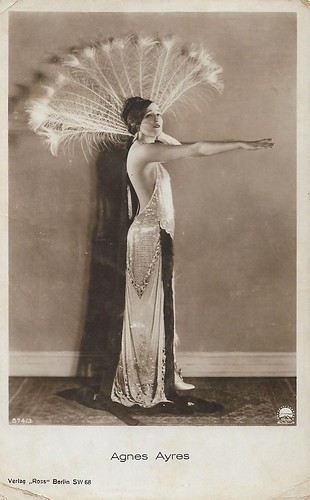
German postcard by Ross Verlag, no. 874/3, 1925-1926. Photo: Paramount.
The O. Henry Girl
Agnes Ayres was born as Agnes Eyre Henkel in Carbondale, Illinois, in 1898, to Solon and Emma (née Slack) Henkel. She had an older brother, Solon William Henkel, who was a decade her senior.
She began her career in 1914 in Chicago, where she was studying at school. During a studio tour, she was noticed by an Essanay Studios staff director and cast as an extra in a crowd scene. She appeared in His New Job (Charles Chaplin, 1915) with Charlie Chaplin . More bit parts and extra roles followed in Essanay productions.
After moving to Manhattan with her mother she pursued a career in acting. Her first big break came at Vitagraph when Ayres was spotted by actress Alice Joyce. Joyce noticed the physical resemblance the two shared. Ayres was cast as Joyce's character's sister in Richard the Brazen (Perry N. Vekroff, 1917).
I the following years, Agnes Ayres was nicknamed 'The O. Henry Girl' because she appeared in so many two-reel films based on O. Henry short stories for Vitagraph.
In 1920, Ayres was signed by Paramount Pictures. Her career began to gain momentum when Paramount founder Jesse Lasky began to take an interest in her. Lasky gave her a starring role in the Civil War drama Held by the Enemy (Donald Crisp, 1920).
It was during this time that Ayres married, and quickly divorced, Captain Frank P. Schuker, an army officer whom she had wed during World War I. She had also begun a romance with Jesse Lasky.
In 1921, Ayres shot to stardom when she was cast as Lady Diana Mayo, an English heiress in the romantic melodrama The Sheik (George Melford, 1921). The film was a box-office hit and helped propel 'Latin lover' Rudolph Valentino to stardom. Ayres later reprised her role as Lady Diana in the sequel Son of the Sheik (George Fitzmaurice, 1926), which premiered nationwide after Valentino's death in August 1926.
Following the release of The Sheik, she went on to have major roles in many other films. Lasky lobbied for parts for her in several Cecil B. DeMille productions. She starred in the comedy-drama The Affairs of Anatol (Cecil B. DeMille, 1921) starring Wallace Reid and Gloria Swanson , Forbidden Fruit (Cecil B. DeMille, 1921), and the epic The Ten Commandments (Cecil B. DeMille, 1923). In the latter, Ayres appeared briefly as 'the Outcast' in the film's closing Nativity tableau.
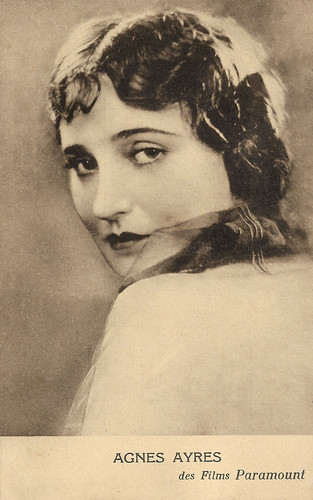
French postcard. Photo: Paramount.
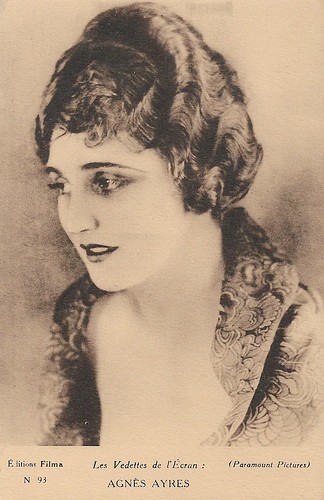
French postcard in the Les vedettes de l'écran series by Editions Filma, no. 93. Photo: Paramount Pictures.
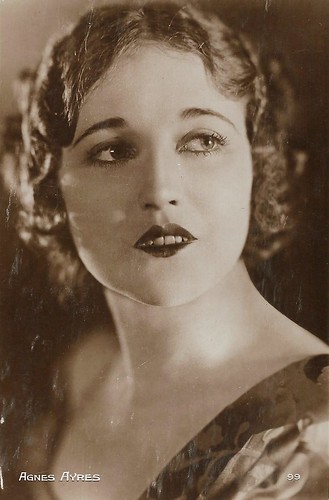
French postcard by Editions Cinémagazine, Paris, no. 99.
A waning career
By 1923, Agnes Ayres' career began to wane following the end of her relationship with Jesse Lasky. She married Mexican diplomat S. Manuel Reachi in 1924. The couple had a daughter before divorcing in 1927.
Ayres lost her fortune and real estate holdings in the Wall Street Crash of 1929. That same year, she also appeared in her last major role in the sound film The Donovan Affair (Frank Capra, 1929), starring Jack Holt and Dorothy Revier. Nothing much came of it. To earn money, she left acting and played the vaudeville circuit.
She returned to acting in 1936, confident that she could make a comeback with a small part in Souls at Sea (Henry Hathaway, 1937), starring Gary Cooper and George Raft. However, she was unable to secure starring roles. Somewhat overweight, Ayres appeared in mostly uncredited bit parts at MGM, where she had a stock-player contract. In 1937, she finally retired from acting for good.
After her retirement, she wanted to start a real-estate business in Beverly Hills, California. However, Ayres became despondent and was eventually committed to a sanatorium. In 1939, she also lost custody of her daughter to Reachi.
Agnes Ayres died from a cerebral hemorrhage on Christmas Day 1940, at her Hollywood home. She was only 42, and had been ill for several weeks. Ayres is interred at Hollywood Forever Cemetery. In 1960, Ayres was inducted into the Hollywood Walk of Fame with a motion pictures star at 6504 Hollywood Boulevard for her contributions to the film industry.
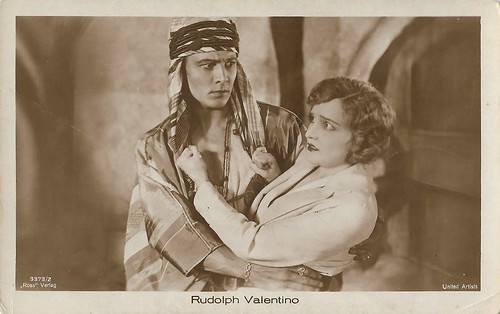
German postcard by Ross Verlag, no. 3373/2. Photo: United Artists. Agnes Ayres and Rudolph Valentino in The Son of the Sheik (George Fitzmaurice, 1926), retaking a scene from the original Paramount production The Sheik (George Melford, 1921).
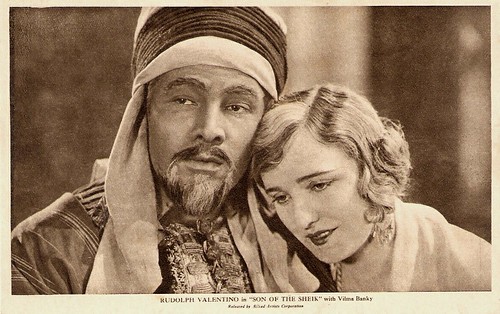
French postcard in a series by Shampoing Butywave. Photo: Allied Artists. Agnes Ayres and Rudolph Valentino in The Son of the Sheik (George Fitzmaurice, 1926). Despite the card telling the lady in question is Vilma Bánky , it is Agnes Ayres. Ayres and Valentino play the parents of the leading character, who is also played by Valentino. Actually the parents are the former protagonists of the earlier film The Sheik, now grown older.
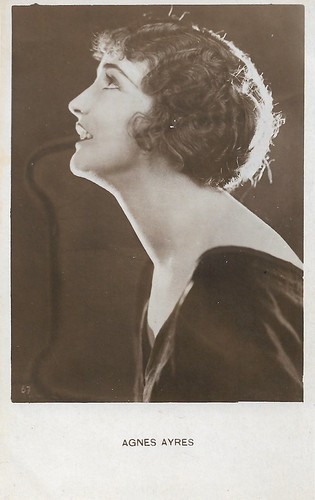
Vintage postcard, country and editor unknown, no. 67.
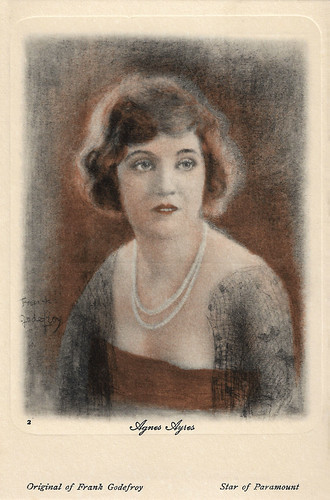
British postcard in the Famous Filmstar series for the Continental Nuss, J.M.H., Laren, Holland. Picture: Frank Godefroy. Paramount.
Sources: Hal Erickson (AllMovie), Wikipedia and .

German postcard by Ross Verlag, no. 874/1. Photo: Paramount.

British postcard in the Picturegoer Series, London, no. 1a.

German postcard by Ross Verlag, no. 874/3, 1925-1926. Photo: Paramount.
The O. Henry Girl
Agnes Ayres was born as Agnes Eyre Henkel in Carbondale, Illinois, in 1898, to Solon and Emma (née Slack) Henkel. She had an older brother, Solon William Henkel, who was a decade her senior.
She began her career in 1914 in Chicago, where she was studying at school. During a studio tour, she was noticed by an Essanay Studios staff director and cast as an extra in a crowd scene. She appeared in His New Job (Charles Chaplin, 1915) with Charlie Chaplin . More bit parts and extra roles followed in Essanay productions.
After moving to Manhattan with her mother she pursued a career in acting. Her first big break came at Vitagraph when Ayres was spotted by actress Alice Joyce. Joyce noticed the physical resemblance the two shared. Ayres was cast as Joyce's character's sister in Richard the Brazen (Perry N. Vekroff, 1917).
I the following years, Agnes Ayres was nicknamed 'The O. Henry Girl' because she appeared in so many two-reel films based on O. Henry short stories for Vitagraph.
In 1920, Ayres was signed by Paramount Pictures. Her career began to gain momentum when Paramount founder Jesse Lasky began to take an interest in her. Lasky gave her a starring role in the Civil War drama Held by the Enemy (Donald Crisp, 1920).
It was during this time that Ayres married, and quickly divorced, Captain Frank P. Schuker, an army officer whom she had wed during World War I. She had also begun a romance with Jesse Lasky.
In 1921, Ayres shot to stardom when she was cast as Lady Diana Mayo, an English heiress in the romantic melodrama The Sheik (George Melford, 1921). The film was a box-office hit and helped propel 'Latin lover' Rudolph Valentino to stardom. Ayres later reprised her role as Lady Diana in the sequel Son of the Sheik (George Fitzmaurice, 1926), which premiered nationwide after Valentino's death in August 1926.
Following the release of The Sheik, she went on to have major roles in many other films. Lasky lobbied for parts for her in several Cecil B. DeMille productions. She starred in the comedy-drama The Affairs of Anatol (Cecil B. DeMille, 1921) starring Wallace Reid and Gloria Swanson , Forbidden Fruit (Cecil B. DeMille, 1921), and the epic The Ten Commandments (Cecil B. DeMille, 1923). In the latter, Ayres appeared briefly as 'the Outcast' in the film's closing Nativity tableau.

French postcard. Photo: Paramount.

French postcard in the Les vedettes de l'écran series by Editions Filma, no. 93. Photo: Paramount Pictures.

French postcard by Editions Cinémagazine, Paris, no. 99.
A waning career
By 1923, Agnes Ayres' career began to wane following the end of her relationship with Jesse Lasky. She married Mexican diplomat S. Manuel Reachi in 1924. The couple had a daughter before divorcing in 1927.
Ayres lost her fortune and real estate holdings in the Wall Street Crash of 1929. That same year, she also appeared in her last major role in the sound film The Donovan Affair (Frank Capra, 1929), starring Jack Holt and Dorothy Revier. Nothing much came of it. To earn money, she left acting and played the vaudeville circuit.
She returned to acting in 1936, confident that she could make a comeback with a small part in Souls at Sea (Henry Hathaway, 1937), starring Gary Cooper and George Raft. However, she was unable to secure starring roles. Somewhat overweight, Ayres appeared in mostly uncredited bit parts at MGM, where she had a stock-player contract. In 1937, she finally retired from acting for good.
After her retirement, she wanted to start a real-estate business in Beverly Hills, California. However, Ayres became despondent and was eventually committed to a sanatorium. In 1939, she also lost custody of her daughter to Reachi.
Agnes Ayres died from a cerebral hemorrhage on Christmas Day 1940, at her Hollywood home. She was only 42, and had been ill for several weeks. Ayres is interred at Hollywood Forever Cemetery. In 1960, Ayres was inducted into the Hollywood Walk of Fame with a motion pictures star at 6504 Hollywood Boulevard for her contributions to the film industry.

German postcard by Ross Verlag, no. 3373/2. Photo: United Artists. Agnes Ayres and Rudolph Valentino in The Son of the Sheik (George Fitzmaurice, 1926), retaking a scene from the original Paramount production The Sheik (George Melford, 1921).

French postcard in a series by Shampoing Butywave. Photo: Allied Artists. Agnes Ayres and Rudolph Valentino in The Son of the Sheik (George Fitzmaurice, 1926). Despite the card telling the lady in question is Vilma Bánky , it is Agnes Ayres. Ayres and Valentino play the parents of the leading character, who is also played by Valentino. Actually the parents are the former protagonists of the earlier film The Sheik, now grown older.

Vintage postcard, country and editor unknown, no. 67.

British postcard in the Famous Filmstar series for the Continental Nuss, J.M.H., Laren, Holland. Picture: Frank Godefroy. Paramount.
Sources: Hal Erickson (AllMovie), Wikipedia and .
Published on September 22, 2019 22:00
September 21, 2019
The Kessler Twins
In the 1950s and 1960s the gorgeous twin sisters Alice & Ellen Kessler (1936) were very popular in Europe, especially in Germany and Italy. In 1959 the singing, dancing and acting duo represented Germany at the Eurovision Song Contest.

German postcard by Krüger, no. 902/199. Photo: Gérard Decaux.
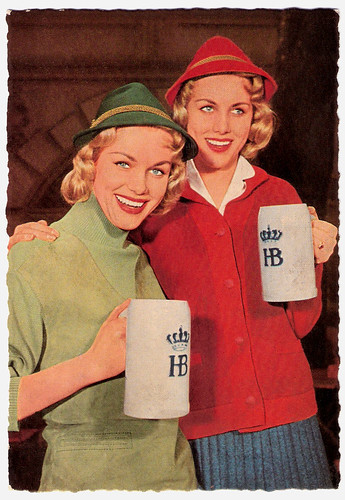
German postcard by WS-Druck, Wanne-Eickel. Photo: Gloria-Film.
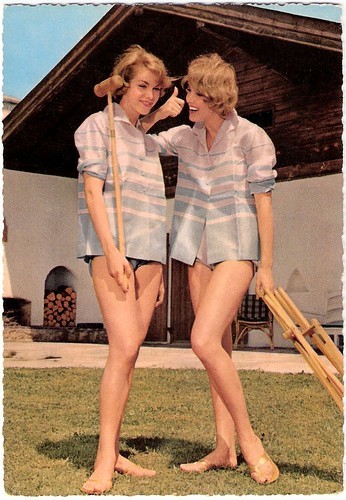
German postcard by Krüger, no. 902/154. Photo: UFA.
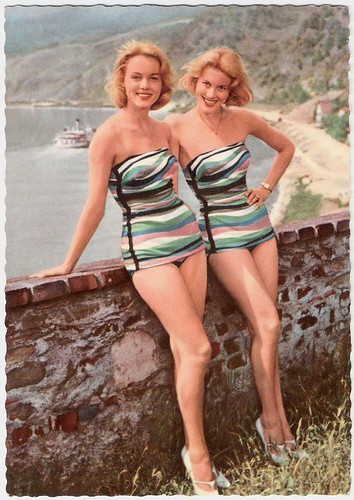
German postcard by UFA (Universum-Film Aktiengesellschaft, Berlin-Tempelhof), no. CK-115. Retail price: 30 Pfg. Photo: Joe Niczky / UFA.
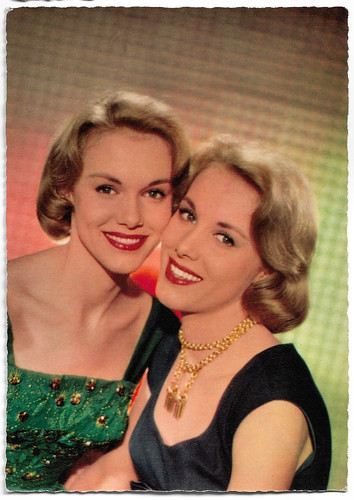
German postcard by Franz Josef Rüdel, Filmpostkartenverlag, Hamburg-Bergedorf, no. FT 18. Photo: Erma / Gloria-Film / Czerwonski. Alice and Ellen Kessler in Scherben bringen Glück/Seven Years Hard Luck (Ernst Marischka, 1957).
Featherlight films
The German twin sisters Alice and Ellen Kessler (originally Kaessler) were born in Nerchau, Germany in 1936. They are usually credited as the Kessler Twins (Die Kessler-Zwillinge in Germany and Le Gemelle Kessler in Italy).
Their parents, Paul and Elsa Kaessler, sent them to ballet classes at the age of six, and they joined the Leipzig Opera's child ballet program at age 11. In 1952, their parents used a visitor's visa to escape to West Germany, where the 18-year-old twins performed at the Palladium in Düsseldorf.
Soon followed parts in such featherlight entertainment films like Solang' es hübsche Mädchen gibt/Beautiful Girls (Arthur Maria Rabenalt, 1955) with Georg Thomalla , the operetta Der Bettelstudent/The Beggar Student (Werner Jacobs, 1955) and another operetta Der Graf von Luxemburg/The Count of Luxemburg (Werner Jacobs, 1957) with Gerhard Riedmann .
Between 1955 and 1960, they also performed at the famous Lido variety hall at the Champs-Élysées in Paris, and they also appeared in French musical films as La garçonne (Jacqueline Audry, 1957) with Fernand Gravey , Tabarin (Richard Pottier, 1958) starring Michel Piccoli, and the anthology film La française et l'amour/Love and the Frenchwoman (Henri Verneuil a.o., 1960), starring Jean-Paul Belmondo .
A year later, the twins represented West Germany at the 1959 Eurovision Song Contest. They finished in 8th place with 'Heute Abend wollen wir tanzen geh'n' (Tonight we want to go dancing).
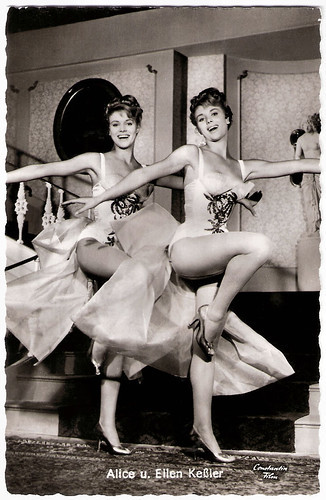
German postcard by Kolibri Verlag G.m.b.H, Minden/Westf., no. 2797. Photo: CCC / Constantin Film/ Arthur Grimm. Alice & Ellen Kessler in Der Graf von Luxemburg/The Count of Luxemburg (Werner Jacobs, 1957).
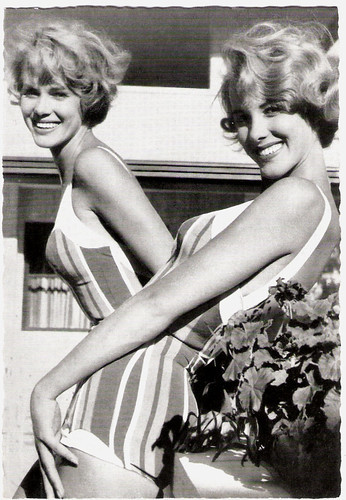
German postcard by WS-Druck, Wanne-Eickel, no. 398. Photo: Polydor / Seitz / Constantin / Looschen.
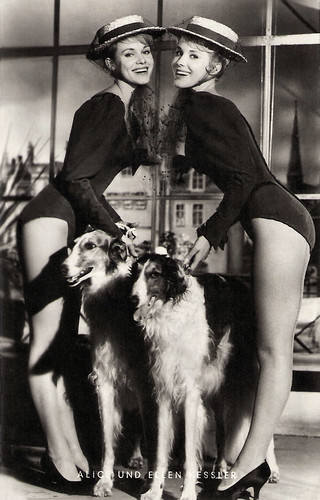
German postcard by Netter's Star Verlag, Berlin.
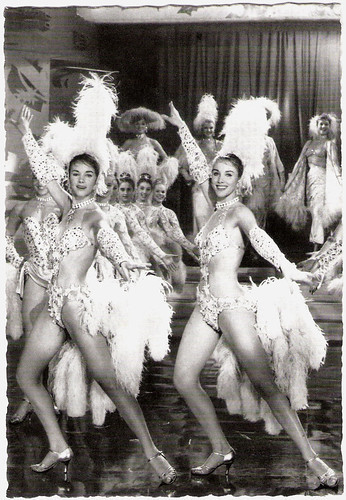
German postcard by WS-Druck, Wanne-Eickel, no. 305. Photo: Defir.
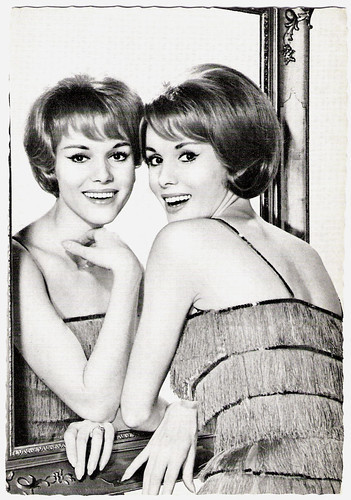
German postcard by Filmbilder-Vertrieb Ernst Freihoff, Essen, no. 734. Photo: Polydor / Klaus Collignon.
Playboy
Alice & Ellen Kessler moved to Italy in 1960. There they had already appeared as themselves in Le bellissime gambe di Sabrina/The Beautiful Legs of Sabrina (Camillo Mastrocinque, 1959) featuring American sex symbol Mamie van Doren .
Gradually they got more serious roles in such films as the adventure film Gli Invasori/Erik the Conqueror (Mario Bava, 1961) starring Cameron Mitchell and Sodom and Gomorrah (Robert Aldrich, 1962) starring Stewart Granger .
In the USA, they were not as popular, but in 1963 they appeared on the cover of Life Magazine and during the 1960s they often worked for TV and in Las Vegas.
During the following decades they worked mostly for TV in Europe. At the age of 40, they agreed to pose on the cover of the Italian edition of Playboy. That issue became reportedly the fastest-selling Italian Playboy up until that point.
They moved back to Germany in 1986 and currently live in Munich. They received the Bundesverdienstkreuz am Bande (highest German order) in 1987 and the Premio Capo Circe for their achievements in German-Italian understanding.
Most recently, Alice and Ellen Kessler played in the episode Das Dorf/The Village (Justus von Dohnányi, 2011) of the popular German Krimi series Tatort. They live in Grünwald.
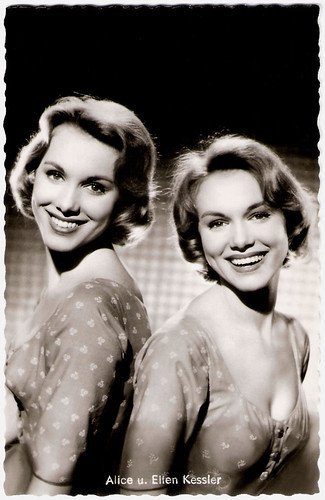
German postcard by Kolibri-Verlag, Minden/Westf., no. 2964.
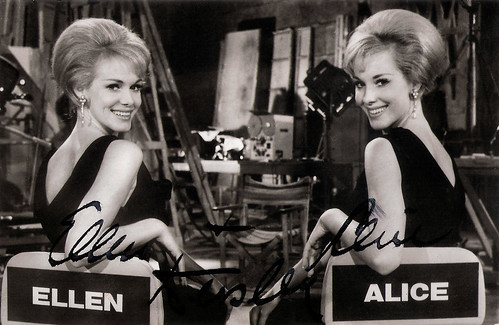
German postcard by Graphima, Berlin.
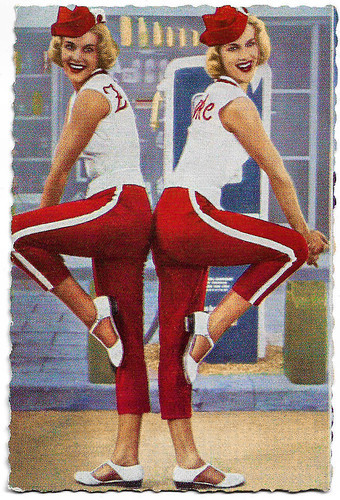
German collectors card by Druckerei Hanns Uhrig, Frankfurt a.M. Photo: Cosmos / NF / Wanke. Alice and Ellen Kessler in Vier Mädel aus der Wachau/Four girls from the Wachau (Franz Antel, 1957).
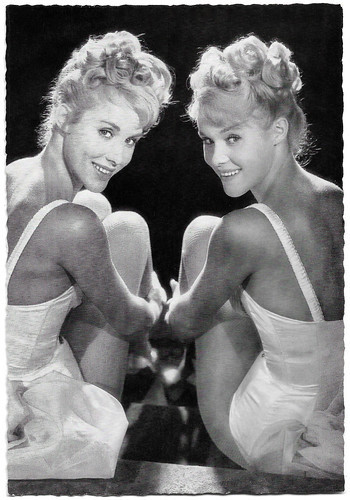
German postcard by WS-Druck, Wanne-Eickel, no. 495.
The Kessler Twins and Peter Alexander perform Ich spiel mit dir (1962). Source: Fritz51251 (YouTube).
The Kessler Twins sing Heute Abend wollen wir tanzen geh'n at the 1959 Eurovision Song Contest. Source: Joao Velado (YouTube).
Sources: Wikipedia and .

German postcard by Krüger, no. 902/199. Photo: Gérard Decaux.

German postcard by WS-Druck, Wanne-Eickel. Photo: Gloria-Film.

German postcard by Krüger, no. 902/154. Photo: UFA.

German postcard by UFA (Universum-Film Aktiengesellschaft, Berlin-Tempelhof), no. CK-115. Retail price: 30 Pfg. Photo: Joe Niczky / UFA.

German postcard by Franz Josef Rüdel, Filmpostkartenverlag, Hamburg-Bergedorf, no. FT 18. Photo: Erma / Gloria-Film / Czerwonski. Alice and Ellen Kessler in Scherben bringen Glück/Seven Years Hard Luck (Ernst Marischka, 1957).
Featherlight films
The German twin sisters Alice and Ellen Kessler (originally Kaessler) were born in Nerchau, Germany in 1936. They are usually credited as the Kessler Twins (Die Kessler-Zwillinge in Germany and Le Gemelle Kessler in Italy).
Their parents, Paul and Elsa Kaessler, sent them to ballet classes at the age of six, and they joined the Leipzig Opera's child ballet program at age 11. In 1952, their parents used a visitor's visa to escape to West Germany, where the 18-year-old twins performed at the Palladium in Düsseldorf.
Soon followed parts in such featherlight entertainment films like Solang' es hübsche Mädchen gibt/Beautiful Girls (Arthur Maria Rabenalt, 1955) with Georg Thomalla , the operetta Der Bettelstudent/The Beggar Student (Werner Jacobs, 1955) and another operetta Der Graf von Luxemburg/The Count of Luxemburg (Werner Jacobs, 1957) with Gerhard Riedmann .
Between 1955 and 1960, they also performed at the famous Lido variety hall at the Champs-Élysées in Paris, and they also appeared in French musical films as La garçonne (Jacqueline Audry, 1957) with Fernand Gravey , Tabarin (Richard Pottier, 1958) starring Michel Piccoli, and the anthology film La française et l'amour/Love and the Frenchwoman (Henri Verneuil a.o., 1960), starring Jean-Paul Belmondo .
A year later, the twins represented West Germany at the 1959 Eurovision Song Contest. They finished in 8th place with 'Heute Abend wollen wir tanzen geh'n' (Tonight we want to go dancing).

German postcard by Kolibri Verlag G.m.b.H, Minden/Westf., no. 2797. Photo: CCC / Constantin Film/ Arthur Grimm. Alice & Ellen Kessler in Der Graf von Luxemburg/The Count of Luxemburg (Werner Jacobs, 1957).

German postcard by WS-Druck, Wanne-Eickel, no. 398. Photo: Polydor / Seitz / Constantin / Looschen.

German postcard by Netter's Star Verlag, Berlin.

German postcard by WS-Druck, Wanne-Eickel, no. 305. Photo: Defir.

German postcard by Filmbilder-Vertrieb Ernst Freihoff, Essen, no. 734. Photo: Polydor / Klaus Collignon.
Playboy
Alice & Ellen Kessler moved to Italy in 1960. There they had already appeared as themselves in Le bellissime gambe di Sabrina/The Beautiful Legs of Sabrina (Camillo Mastrocinque, 1959) featuring American sex symbol Mamie van Doren .
Gradually they got more serious roles in such films as the adventure film Gli Invasori/Erik the Conqueror (Mario Bava, 1961) starring Cameron Mitchell and Sodom and Gomorrah (Robert Aldrich, 1962) starring Stewart Granger .
In the USA, they were not as popular, but in 1963 they appeared on the cover of Life Magazine and during the 1960s they often worked for TV and in Las Vegas.
During the following decades they worked mostly for TV in Europe. At the age of 40, they agreed to pose on the cover of the Italian edition of Playboy. That issue became reportedly the fastest-selling Italian Playboy up until that point.
They moved back to Germany in 1986 and currently live in Munich. They received the Bundesverdienstkreuz am Bande (highest German order) in 1987 and the Premio Capo Circe for their achievements in German-Italian understanding.
Most recently, Alice and Ellen Kessler played in the episode Das Dorf/The Village (Justus von Dohnányi, 2011) of the popular German Krimi series Tatort. They live in Grünwald.

German postcard by Kolibri-Verlag, Minden/Westf., no. 2964.

German postcard by Graphima, Berlin.

German collectors card by Druckerei Hanns Uhrig, Frankfurt a.M. Photo: Cosmos / NF / Wanke. Alice and Ellen Kessler in Vier Mädel aus der Wachau/Four girls from the Wachau (Franz Antel, 1957).

German postcard by WS-Druck, Wanne-Eickel, no. 495.
The Kessler Twins and Peter Alexander perform Ich spiel mit dir (1962). Source: Fritz51251 (YouTube).
The Kessler Twins sing Heute Abend wollen wir tanzen geh'n at the 1959 Eurovision Song Contest. Source: Joao Velado (YouTube).
Sources: Wikipedia and .
Published on September 21, 2019 22:00
September 20, 2019
New acquisitions: Cinémagazine, Part 2
Last Saturday, EFSP had a post with a series of French postcards by Editions Cinémagazine, recently acquired by Ivo Blom. We love these sepia postcards of the 1920s, and have many more in our collections. Last week, we published 25 Cinémagazine cards with Hollywood stars. For today, we chose 25 cards with European stars, which we did not publish before.
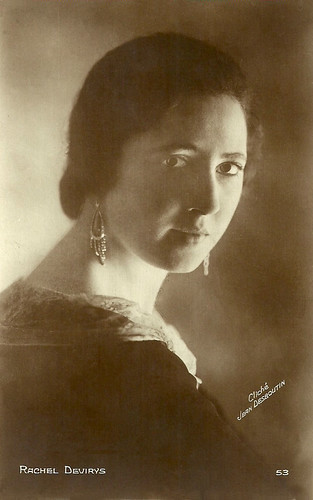
French postcard by Editions Cinémagazine, no. 53. Photo: Jean Desboutin.
Rachel Devirys (1890-1983) was a Franco-Russian actress, who started in French cinema in 1917 and is known for such films as Visages d'enfants (Jacques Feyder, 1923) as the stepmother of Jean Forest , Monte Carlo (Louis Mercanton, 1925) with Betty Balfour , and Croquette (Mercanton, 1928) again with Balfour. Devirys continued well into the sound era, with films such as Maternité (Jean Benoît-Lévy, 1930). One of her last parts was in Les enfants terribles (Jean-Pierre Melville, 1950).
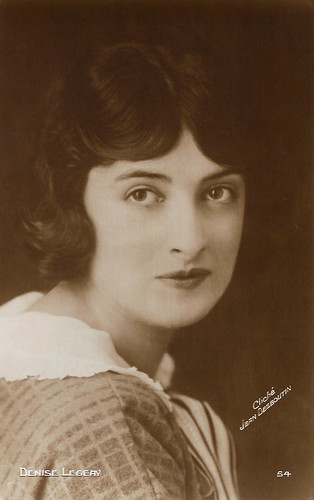
French postcard by Editions Cinémagazine, no. 54. Photo: Jean Desboutin.
Denise Legeay (1898-1968) was a French film actress whose career and popularity peaked in the first half of the 1920s. Legeay debuted in L'infante à la rose (Henry Houry, 1921), starring Gabrielle Dorziat. In the episode film Vingt ans après (Henri Diamant-Berger, 1922), the sequel to Les trois mousquetaires (1921), Legeay played Anne Geneviève de Bourbon, Duchess of Longueville. She also acted opposite Maurice Chevalier in Le mauvais garçon (Henri Diamant-Berger, 1923). Legeay was paired with Harry Piel in Der Mann ohne Nerven (1924) and Face à la mort/ Au secours!/Schneller als der Tod (1924), both directed by both Gérard Bourgeois and Harry Piel . The collaboration lead to two other Harry Piel films in Germany: Zigano (1925), and Achtung Harry! Augen auf! (1926). These were her last films.
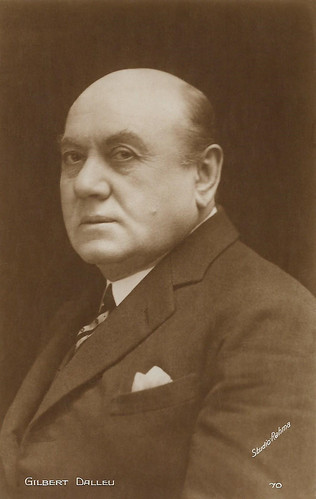
French postcard by Editions Cinémagazine, no. 70. Photo: Studio Rahma.
Gilbert Dalleu (1861-1931) was a French actor of the silent era.
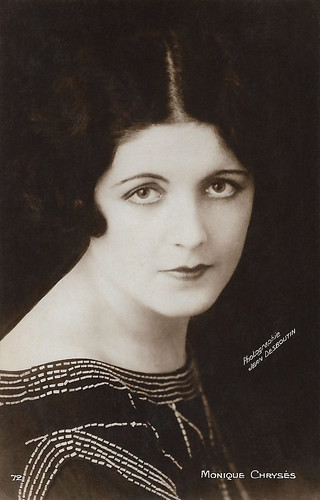
French postcard by Editions Cinémagazine, no. 72. Photo: Jean Desboutin.
Little is known about Monique Chrysès. Her life dates are lacking. She debuted in French silent film in Le père Goriot (Jacques de Baroncelli, 1921), where she played Madame de Restaud opposite Gabriel Signoret as the title character. In 1922 she acted in the Oscar Wilde adaptation Le crime de Lord Arthur Savile (René Hervil, 1922) with the British actor Cecil Mannering as the title character. In 1923 she appeared in Germaine Dulac's serial Gossette (1923) starring Régine Bouet and costarring Maurice Schutz . Then, she was Mme Belmont in L'enfant des halles (René Leprince, 1924) and Marthe Guéroy in L'aventurier (Maurice Mariaud, Louis Osmont, 1924) with Jean Angelo . After years of absence from the screen, Chrysès had a last, supporting part in the sound film La voix qui meurt (Gennaro Dini, 1934) starring André Burdino.
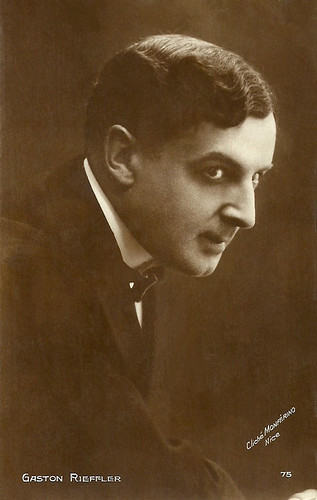
French postcard by Editions Cinémagazine, no. 75. Photo: Monférino, Nice.
Gaston Rieffler (1880-1959) was a French actor who peaked in the French silent cinema of the 1910s and early 1920s.
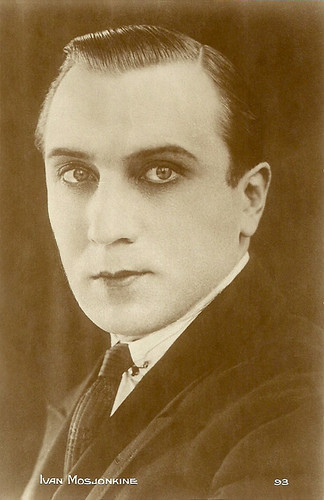
French postcard by Editions Cinémagazine, no. 93.
Russian actor Ivan Mozzhukhin (1889-1939) was a legendary star of the European silent film. He escaped from execution by the Soviet Red Army and made a stellar career in Europe, but he suffered in Hollywood.

French postcard by Editions Cinémagazine, no. 107. Photo: Wyndham.
Ginette Maddie (1898-1980) was a French actress who acted in French and German silent films. She started opposite Claude Merelle in Le diamant noir (André Hugon, 1922). Maddie had female leads in Sarati le terrible (René Hervil, Louis Mercanton, 1923), the comedy Les héritiers de l'oncle James (Alfred Machin, Henry Wulschleger, 1924), and La lueur dans les ténèbres (Maurice Charmeroy, 1928), while she often played the second woman in the story in French and German films opposite e.g. Dolly Davis , Madeleine Erickson, Xenia Desni , and Dita Parlo .
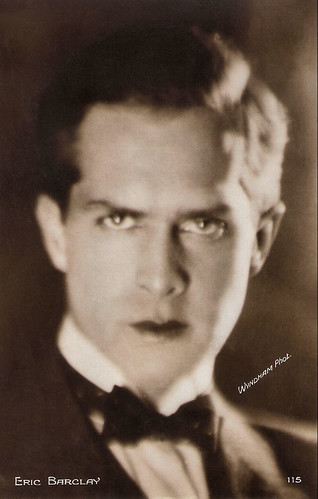
French postcard by Editions Cinémagazine, no. 115. Photo: Wyndham.
Eric Barclay (1894–1938) was a Swedish film actor. Barclay became a prominent actor in French silent films of the early 1920s, often working with director Jacques de Baroncelli. He also appeared in German and British films and those of his native Sweden.
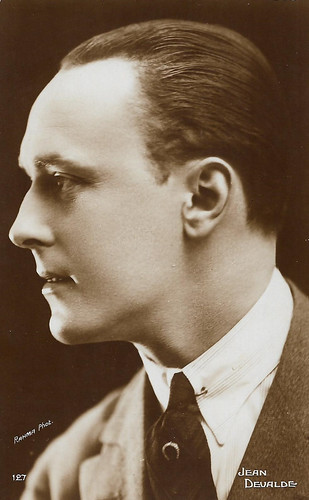
French postcard by Editions Cinémagazine, no. 127. Photo: Rahma.
Jean Devalde (1888-1982) was a Belgian actor in French silent cinema. After his career as actor, Devalde became impresario of Pierre Fresnay , Yvonne Printemps , Pierre Richard-Willm and Edwige Feuillère .
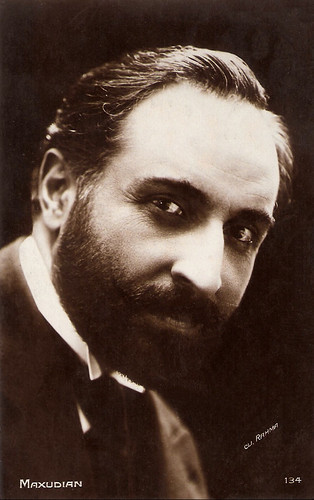
French postcard by Editions Cinémagazine, no. 134. Photo: Rahma.
Max Maxudian (1881-1976) was a French stage and film actor with tall, broad shoulders, a high forehead under hair thrown-back, a Bourbon nose, a black beard framing an energetic face, tempered by Oriental eyes. He appeared in supporting parts in 77 films, including some of the silent classics of Abel Gance like the epic Napoleon (1927).
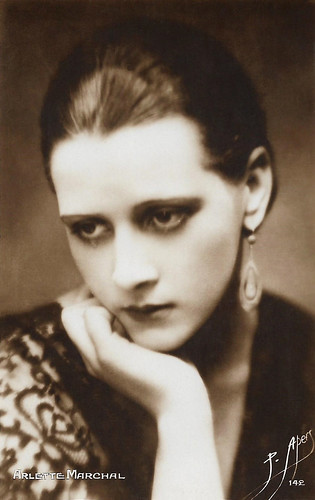
French postcard by Editions Cinémagazine, no. 142. Photo: P. Apers.
Elegant French actress Arlette Marchal (1902-1984) started as a fashion model and from the 1950s on she dedicated herself mostly to her fashion enterprise. Between 1922 and 1951 she starred in 41 European and American films.
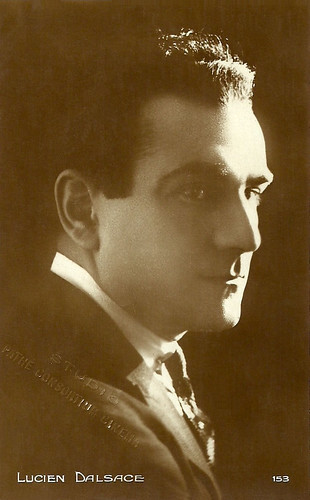
French postcard by Editions Cinémagazine, no. 153.
Lucien Dalsace (1893-1980) was a French stage and screen actor who peaked in French silent cinema of the 1920s.
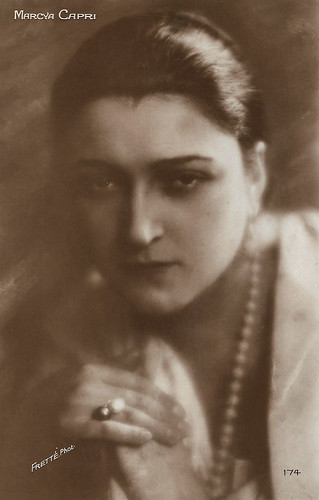
French postcard by Editions Cinémagazine, no. 174. Photo: Fretté.
Little is known about Marcya Capri, no life dates are known. She was first seen in The Empire of Diamonds (Léonce Perret, 1920), an American film shot on location in the South of France and elsewhere. Perret then hired her for major parts in The Money Maniac (1921) starring Robert Elliott, and his French production, L'écuyère (1922). She had a smaller part in Perret's superproduction Koenigsmark (1923), starring Huguette Duflos as Grandduchess Aurore and Jaque Catelain as her tutor Raoul Vignerte. Capri played Melusine de Graffenfried, the Grand Duchess's head of staff. Afterwards, Capri acted in La closerie des Genets (André Liabel, 1925) opposite Henry Krauss and Ninna Vanna. In Les deux mamans (Giuseppe Guarino, 1925), and the Franco-Romanian production Calvaire/ Drumul iertarii (Ion Niculescu-Bruna, Gabriel Rosca, 1927). Capri acted opposite Soava Gallone as the Other Woman in Celle qui domine (Carmine Gallone, Léon Mathot, 1927). After some bit parts and years of absence from the screen, she returned in 1936 for a small part in the sound film Marinella (Pierre Caron, 1936), starring Tino Rossi and Yvette Lebon .
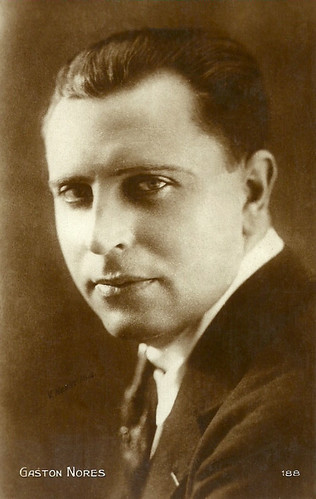
French postcard by Editions Cinémagazine, no. 188. Photo: V. Henry.
Gaston Norès (1894-1958) was a Belgian actor, who first chose operetta as his career and triumphed as Prince Danilo in 'The Merry Widow', just before the First World War. After four years at the front, his vocal cords were ruined and he could not sing anymore. He was introduced to film director Gérard Bourgeois and became the lead in the two-part film La dette de sang (1922) and instantly a star. Several films followed, a.o. the serial Tao (Gaston Ravel, 1923), in which he played the young adventurer Jacques Chauvry opposite Joë Hamman . The 10-episodes serial was a huge success. He only played in 12 films and often had supporting parts. At the advent of sound cinema, Norès's career was over. His last film was the early sound film Les papillons de nuit (Maurice Kéroul, 1930).
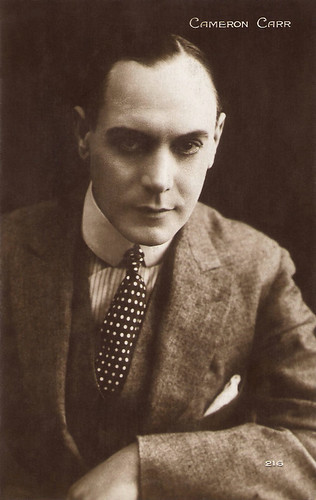
French postcard by Editions Cinémagazine, no. 216.
Cameron Carr (1876-1944) was a British film actor of the silent era. Carr started his career in 1918, working for Broadwest, directed by Walter West. Often he was the other man opposite leading man Stewart Rome , with actress Violet Hopson in the middle. In 1922 he alternated his work at Broadwest with Stewart and Hopson, with roles at Stoll Pictures. There he worked in films by and with Guy Newall, and with Ivy Duke. Carr had his first lead in 1925 in the Stoll production The Notorious Mrs. Carrick, playing David Carrick. In several films, Carr played second fiddle to Clive Brook or Victor McLaglen . From 1927, he mainly played supporting parts for BIP.
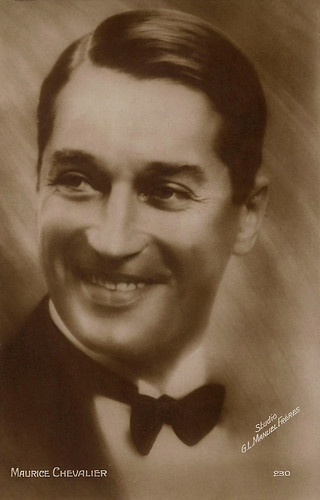
French postcard by Editions Cinémagazine, no. 230. Photo: Studio G.L. Manuel Frères.
Maurice Chevalier (1888-1972) was a French actor, singer and entertainer. His trademark was a casual straw hat, which he always wore on stage with a cane and a tuxedo.
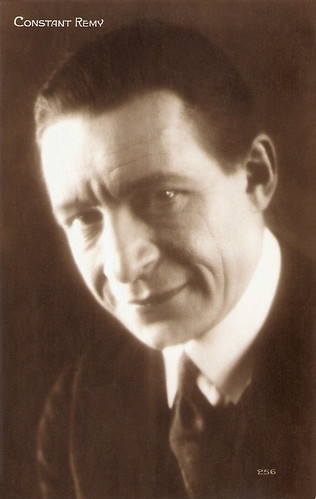
French postcard by Editions Cinémagazine, no. 256.
Constant Rémy (1882-1957) was a French actor and director, who played in almost 70 films.
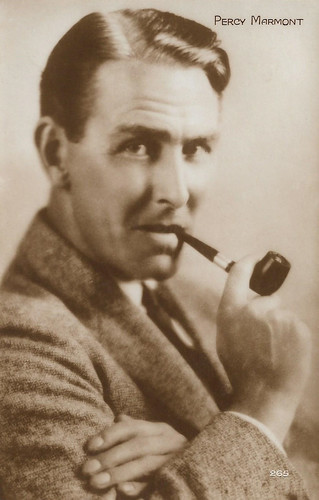
French postcard by Editions Cinémagazine, no. 265.
Percy Marmont (1883-1977) was a British actor, who had a prolific career in 1920s Hollywood and 1930s British cinema.

French postcard by Editions Cinémagazine, no. 268.
Jean Dehelly (1896-1964) was a French film actor, who was active in French cinema of the 1920s and early 1930s.
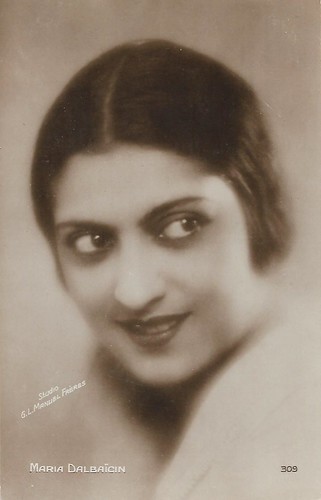
French postcard by Editions Cinémagazine, no. 309. Photo: Studio G.L. Manuel Frères.
María Dalbaicín (1902-1931) was a Spanish flamenco dancer who became an actress. Dalbaicín grew up in a gypsy family and her mother Agustina Escudero Heredia was nicknamed the 'Queen of Gypsies'. From 1925 on, she appeared in French and German films. When she died in 1931, she was only 28.
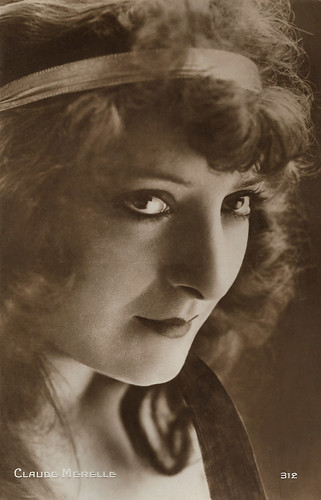
French postcard by Editions Cinémagazine, no. 312.
Claude Mérelle (1888-?) was a French film actress of the silent era. She is best remembered as the evil Milady de Winter in Les trois mousquetaires/The Three Musketeers (Henri Diamant-Berger, 1921).
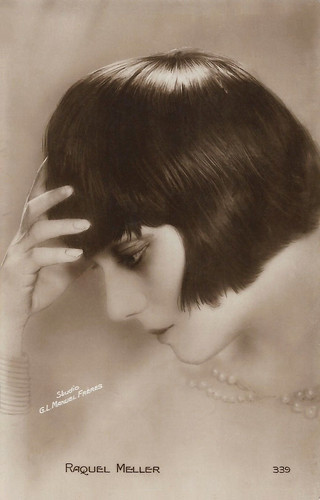
French postcard by Editions Cinémagazine, no. 339. Photo: Studio G.L. Manuel Frères.
Spanish actress, singer, and diva Raquel Meller acted mainly in French silent films. She was already a highly popular singer before debuting as a film actress in 1919.
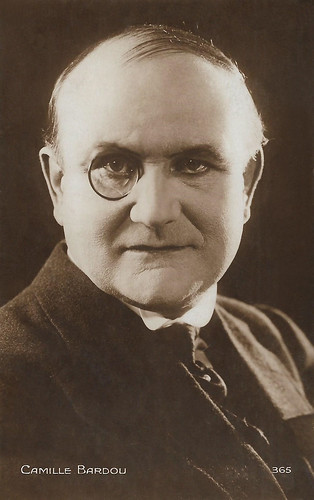
French postcard by Editions Cinémagazine, no. 365.
Camille Bardou (1872-1941) was a French stage and screen actor, who acted in cinema between 1904 and 1934.
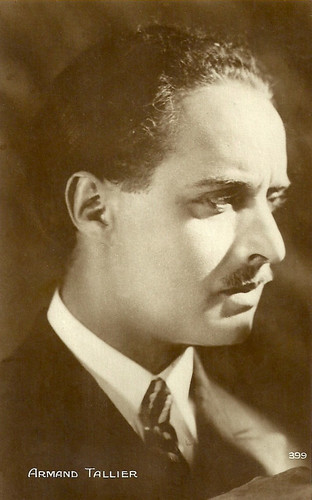
French postcard by Editions Cinémagazine, no. 399.
Armand Tallier (1887-1958) was a stage and screen actor, who peaked in the silent era. Theatre director Jacques Copeau, who had opened the alternative Théâtre du Vieux Colombier, directed Tallier on stage from 1913 for several years. Inspired by him, Tallier began with Laurence Myrga the Studio des Ursulines, one of the first Parisian art houses, founded to ensure the diffusion of avant-garde cinema. The first session took place in January 1926. As an homage, the Prix Armand Tallier for the best book on film is awarded since 1958 (since 1977 called Prix littéraire du syndicat français de la critique de cinéma).
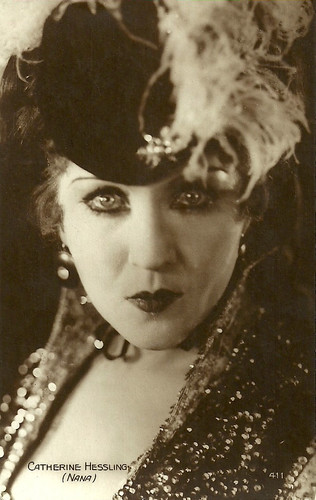
French postcard by Editions Cinémagazine, no. 411. Catherine Hessling as the title character in Nana (Jean Renoir, 1926), based on the homonymous novel (1880) by Emile Zola.
Catherine Hessling (1900-1979) was an attractive brunette with bee-stung lips, who started as a model for the painter Pierre-Auguste Renoir (1917-1919) in the Provence. She married his son Jean in 1920 and they had a son Alain in 1921. From 1924 Hessling acted in Jean Renoir's first films, first in Catherine/Une vie sans joie (1924, re-edited by Albert Dieudonné in 1927), about an orphan girl who is a victim of the jealousy of women and the greed of men. In her second film, La fille de l'eau/The Whirlpool of Fate (1925), Hessling is the daughter of a pole man, whose father drowns and whose uncle tries to rape and rob her. Renoir's next production was the prestigious and costly Nana (Jean Renoir, 1926), filmed at the Bavaria Studios in Munich, and with stars like Jean Angelo and Werner Krauss . Hessling and Renoir became household names.
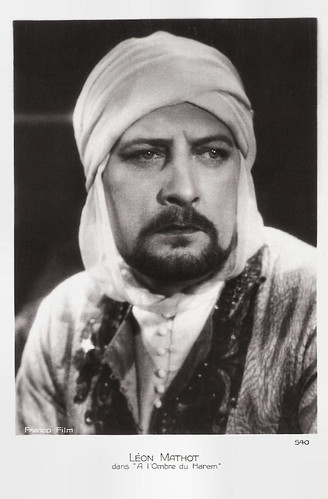
French postcard by Cinémagazine-Edition, no. 540. Photo: Franco Film. Léon Mathot in the French silent film Dans l'ombre du harem/In the Shadow of the Harem (Léon Mathot, André Liabel, 1928). The title on the postcard is slightly incorrect.
Léon Mathot (1886-1968) was a French actor and director, who became well-known for his role of Edmond Dantès in the French serial Le Comte de Monte-Cristo (1918), directed by Henri Pouctal. Mathot became one of the most popular stars of French silent film of the 1920s with such film as L'Empereur des pauvres (René Leprince, 1922) and Coeur fidèle (1923) by Jean Epstein. From 1927, he also became a film director, directing over 20 films.

French postcard by Editions Cinémagazine, no. 53. Photo: Jean Desboutin.
Rachel Devirys (1890-1983) was a Franco-Russian actress, who started in French cinema in 1917 and is known for such films as Visages d'enfants (Jacques Feyder, 1923) as the stepmother of Jean Forest , Monte Carlo (Louis Mercanton, 1925) with Betty Balfour , and Croquette (Mercanton, 1928) again with Balfour. Devirys continued well into the sound era, with films such as Maternité (Jean Benoît-Lévy, 1930). One of her last parts was in Les enfants terribles (Jean-Pierre Melville, 1950).

French postcard by Editions Cinémagazine, no. 54. Photo: Jean Desboutin.
Denise Legeay (1898-1968) was a French film actress whose career and popularity peaked in the first half of the 1920s. Legeay debuted in L'infante à la rose (Henry Houry, 1921), starring Gabrielle Dorziat. In the episode film Vingt ans après (Henri Diamant-Berger, 1922), the sequel to Les trois mousquetaires (1921), Legeay played Anne Geneviève de Bourbon, Duchess of Longueville. She also acted opposite Maurice Chevalier in Le mauvais garçon (Henri Diamant-Berger, 1923). Legeay was paired with Harry Piel in Der Mann ohne Nerven (1924) and Face à la mort/ Au secours!/Schneller als der Tod (1924), both directed by both Gérard Bourgeois and Harry Piel . The collaboration lead to two other Harry Piel films in Germany: Zigano (1925), and Achtung Harry! Augen auf! (1926). These were her last films.

French postcard by Editions Cinémagazine, no. 70. Photo: Studio Rahma.
Gilbert Dalleu (1861-1931) was a French actor of the silent era.

French postcard by Editions Cinémagazine, no. 72. Photo: Jean Desboutin.
Little is known about Monique Chrysès. Her life dates are lacking. She debuted in French silent film in Le père Goriot (Jacques de Baroncelli, 1921), where she played Madame de Restaud opposite Gabriel Signoret as the title character. In 1922 she acted in the Oscar Wilde adaptation Le crime de Lord Arthur Savile (René Hervil, 1922) with the British actor Cecil Mannering as the title character. In 1923 she appeared in Germaine Dulac's serial Gossette (1923) starring Régine Bouet and costarring Maurice Schutz . Then, she was Mme Belmont in L'enfant des halles (René Leprince, 1924) and Marthe Guéroy in L'aventurier (Maurice Mariaud, Louis Osmont, 1924) with Jean Angelo . After years of absence from the screen, Chrysès had a last, supporting part in the sound film La voix qui meurt (Gennaro Dini, 1934) starring André Burdino.

French postcard by Editions Cinémagazine, no. 75. Photo: Monférino, Nice.
Gaston Rieffler (1880-1959) was a French actor who peaked in the French silent cinema of the 1910s and early 1920s.

French postcard by Editions Cinémagazine, no. 93.
Russian actor Ivan Mozzhukhin (1889-1939) was a legendary star of the European silent film. He escaped from execution by the Soviet Red Army and made a stellar career in Europe, but he suffered in Hollywood.

French postcard by Editions Cinémagazine, no. 107. Photo: Wyndham.
Ginette Maddie (1898-1980) was a French actress who acted in French and German silent films. She started opposite Claude Merelle in Le diamant noir (André Hugon, 1922). Maddie had female leads in Sarati le terrible (René Hervil, Louis Mercanton, 1923), the comedy Les héritiers de l'oncle James (Alfred Machin, Henry Wulschleger, 1924), and La lueur dans les ténèbres (Maurice Charmeroy, 1928), while she often played the second woman in the story in French and German films opposite e.g. Dolly Davis , Madeleine Erickson, Xenia Desni , and Dita Parlo .

French postcard by Editions Cinémagazine, no. 115. Photo: Wyndham.
Eric Barclay (1894–1938) was a Swedish film actor. Barclay became a prominent actor in French silent films of the early 1920s, often working with director Jacques de Baroncelli. He also appeared in German and British films and those of his native Sweden.

French postcard by Editions Cinémagazine, no. 127. Photo: Rahma.
Jean Devalde (1888-1982) was a Belgian actor in French silent cinema. After his career as actor, Devalde became impresario of Pierre Fresnay , Yvonne Printemps , Pierre Richard-Willm and Edwige Feuillère .

French postcard by Editions Cinémagazine, no. 134. Photo: Rahma.
Max Maxudian (1881-1976) was a French stage and film actor with tall, broad shoulders, a high forehead under hair thrown-back, a Bourbon nose, a black beard framing an energetic face, tempered by Oriental eyes. He appeared in supporting parts in 77 films, including some of the silent classics of Abel Gance like the epic Napoleon (1927).

French postcard by Editions Cinémagazine, no. 142. Photo: P. Apers.
Elegant French actress Arlette Marchal (1902-1984) started as a fashion model and from the 1950s on she dedicated herself mostly to her fashion enterprise. Between 1922 and 1951 she starred in 41 European and American films.

French postcard by Editions Cinémagazine, no. 153.
Lucien Dalsace (1893-1980) was a French stage and screen actor who peaked in French silent cinema of the 1920s.

French postcard by Editions Cinémagazine, no. 174. Photo: Fretté.
Little is known about Marcya Capri, no life dates are known. She was first seen in The Empire of Diamonds (Léonce Perret, 1920), an American film shot on location in the South of France and elsewhere. Perret then hired her for major parts in The Money Maniac (1921) starring Robert Elliott, and his French production, L'écuyère (1922). She had a smaller part in Perret's superproduction Koenigsmark (1923), starring Huguette Duflos as Grandduchess Aurore and Jaque Catelain as her tutor Raoul Vignerte. Capri played Melusine de Graffenfried, the Grand Duchess's head of staff. Afterwards, Capri acted in La closerie des Genets (André Liabel, 1925) opposite Henry Krauss and Ninna Vanna. In Les deux mamans (Giuseppe Guarino, 1925), and the Franco-Romanian production Calvaire/ Drumul iertarii (Ion Niculescu-Bruna, Gabriel Rosca, 1927). Capri acted opposite Soava Gallone as the Other Woman in Celle qui domine (Carmine Gallone, Léon Mathot, 1927). After some bit parts and years of absence from the screen, she returned in 1936 for a small part in the sound film Marinella (Pierre Caron, 1936), starring Tino Rossi and Yvette Lebon .

French postcard by Editions Cinémagazine, no. 188. Photo: V. Henry.
Gaston Norès (1894-1958) was a Belgian actor, who first chose operetta as his career and triumphed as Prince Danilo in 'The Merry Widow', just before the First World War. After four years at the front, his vocal cords were ruined and he could not sing anymore. He was introduced to film director Gérard Bourgeois and became the lead in the two-part film La dette de sang (1922) and instantly a star. Several films followed, a.o. the serial Tao (Gaston Ravel, 1923), in which he played the young adventurer Jacques Chauvry opposite Joë Hamman . The 10-episodes serial was a huge success. He only played in 12 films and often had supporting parts. At the advent of sound cinema, Norès's career was over. His last film was the early sound film Les papillons de nuit (Maurice Kéroul, 1930).

French postcard by Editions Cinémagazine, no. 216.
Cameron Carr (1876-1944) was a British film actor of the silent era. Carr started his career in 1918, working for Broadwest, directed by Walter West. Often he was the other man opposite leading man Stewart Rome , with actress Violet Hopson in the middle. In 1922 he alternated his work at Broadwest with Stewart and Hopson, with roles at Stoll Pictures. There he worked in films by and with Guy Newall, and with Ivy Duke. Carr had his first lead in 1925 in the Stoll production The Notorious Mrs. Carrick, playing David Carrick. In several films, Carr played second fiddle to Clive Brook or Victor McLaglen . From 1927, he mainly played supporting parts for BIP.

French postcard by Editions Cinémagazine, no. 230. Photo: Studio G.L. Manuel Frères.
Maurice Chevalier (1888-1972) was a French actor, singer and entertainer. His trademark was a casual straw hat, which he always wore on stage with a cane and a tuxedo.

French postcard by Editions Cinémagazine, no. 256.
Constant Rémy (1882-1957) was a French actor and director, who played in almost 70 films.

French postcard by Editions Cinémagazine, no. 265.
Percy Marmont (1883-1977) was a British actor, who had a prolific career in 1920s Hollywood and 1930s British cinema.

French postcard by Editions Cinémagazine, no. 268.
Jean Dehelly (1896-1964) was a French film actor, who was active in French cinema of the 1920s and early 1930s.

French postcard by Editions Cinémagazine, no. 309. Photo: Studio G.L. Manuel Frères.
María Dalbaicín (1902-1931) was a Spanish flamenco dancer who became an actress. Dalbaicín grew up in a gypsy family and her mother Agustina Escudero Heredia was nicknamed the 'Queen of Gypsies'. From 1925 on, she appeared in French and German films. When she died in 1931, she was only 28.

French postcard by Editions Cinémagazine, no. 312.
Claude Mérelle (1888-?) was a French film actress of the silent era. She is best remembered as the evil Milady de Winter in Les trois mousquetaires/The Three Musketeers (Henri Diamant-Berger, 1921).

French postcard by Editions Cinémagazine, no. 339. Photo: Studio G.L. Manuel Frères.
Spanish actress, singer, and diva Raquel Meller acted mainly in French silent films. She was already a highly popular singer before debuting as a film actress in 1919.

French postcard by Editions Cinémagazine, no. 365.
Camille Bardou (1872-1941) was a French stage and screen actor, who acted in cinema between 1904 and 1934.

French postcard by Editions Cinémagazine, no. 399.
Armand Tallier (1887-1958) was a stage and screen actor, who peaked in the silent era. Theatre director Jacques Copeau, who had opened the alternative Théâtre du Vieux Colombier, directed Tallier on stage from 1913 for several years. Inspired by him, Tallier began with Laurence Myrga the Studio des Ursulines, one of the first Parisian art houses, founded to ensure the diffusion of avant-garde cinema. The first session took place in January 1926. As an homage, the Prix Armand Tallier for the best book on film is awarded since 1958 (since 1977 called Prix littéraire du syndicat français de la critique de cinéma).

French postcard by Editions Cinémagazine, no. 411. Catherine Hessling as the title character in Nana (Jean Renoir, 1926), based on the homonymous novel (1880) by Emile Zola.
Catherine Hessling (1900-1979) was an attractive brunette with bee-stung lips, who started as a model for the painter Pierre-Auguste Renoir (1917-1919) in the Provence. She married his son Jean in 1920 and they had a son Alain in 1921. From 1924 Hessling acted in Jean Renoir's first films, first in Catherine/Une vie sans joie (1924, re-edited by Albert Dieudonné in 1927), about an orphan girl who is a victim of the jealousy of women and the greed of men. In her second film, La fille de l'eau/The Whirlpool of Fate (1925), Hessling is the daughter of a pole man, whose father drowns and whose uncle tries to rape and rob her. Renoir's next production was the prestigious and costly Nana (Jean Renoir, 1926), filmed at the Bavaria Studios in Munich, and with stars like Jean Angelo and Werner Krauss . Hessling and Renoir became household names.

French postcard by Cinémagazine-Edition, no. 540. Photo: Franco Film. Léon Mathot in the French silent film Dans l'ombre du harem/In the Shadow of the Harem (Léon Mathot, André Liabel, 1928). The title on the postcard is slightly incorrect.
Léon Mathot (1886-1968) was a French actor and director, who became well-known for his role of Edmond Dantès in the French serial Le Comte de Monte-Cristo (1918), directed by Henri Pouctal. Mathot became one of the most popular stars of French silent film of the 1920s with such film as L'Empereur des pauvres (René Leprince, 1922) and Coeur fidèle (1923) by Jean Epstein. From 1927, he also became a film director, directing over 20 films.
Published on September 20, 2019 22:00
September 19, 2019
Susan Hayward
American actress Susan Hayward (1917-1975) had her greatest roles in I'll Cry Tomorrow (1955) and I Want to Live! (1958). The latter won her an Academy Award for Best Actress. Her ruby mane was her trademark.
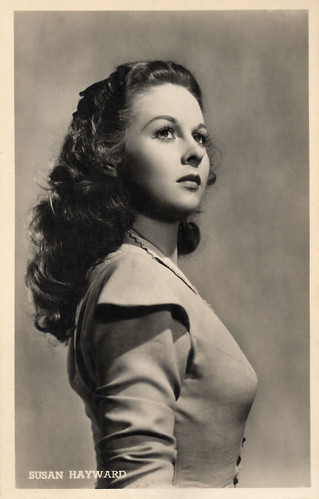
Dutch postcard by J.S.A. (J. Sleding, Amsterdam). Photo: Universal M.P.E.
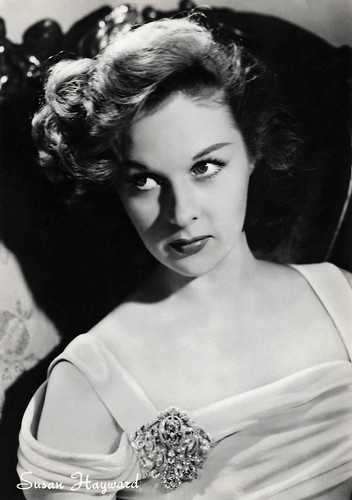
Italian postcard by Rotalfoto, Milano, no. 41.
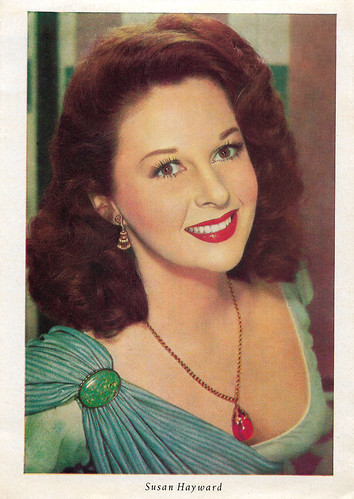
West-German postcard by Wilhelm-Schulze Witteborg (WS-Druck), Wanne-Eickel. Photo: Centfox. Susan Hayward in The Snows of Kilimanjaro (Henry King, 1952).
A life-long grudge
Susan Hayward was born Edythe Marrener in the Flatbush section of Brooklyn, New York, in 1917. Her father was a transportation worker.
The youngest of three children, she grew up in the shadow of her older sister Florence who was her mother's favourite. Edythe would nurse a life-long grudge over what she perceived as her mother's neglect.
She attended public school in Brooklyn, where she graduated from a commercial high school that was intended to give students a marketable skill. She had planned on becoming a secretary, but her plans changed. She started doing some modelling work for photographers in the NYC area.
By 1937, Edythe was brought to Hollywood as one of the hundreds of girls who had won a chance to screen test in the nationwide search for someone to play the role of Scarlett O'Hara in Margaret Mitchell's Gone with the Wind (Victor Fleming, 1939).
Although she lost out to Vivien Leigh , Susan was to carve her own signature in Hollywood circles. It would take several years of studio subsidised acting and voice lessons before her talent would emerge and she would be renamed Susan Hayward.
She got a bit part in Hollywood Hotel (Busby Berkeley, 1937). The bit parts continued all through 1938, with Susan playing, among other things, a coed, a telephone operator and an aspiring actress. She wasn't happy with these bit parts, but she also realised she had to "pay her dues".
In 1939 she finally landed a part with substance, playing Isobel Rivers in the hit action film Beau Geste (William A. Wellman, 1939) with Gary Cooper and Ray Milland .
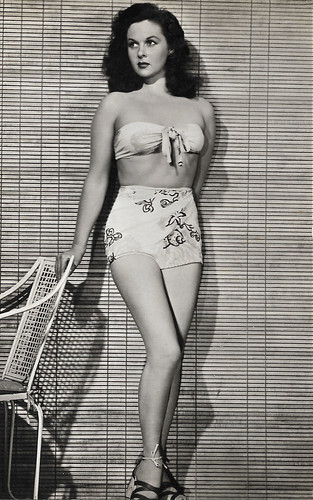
Spanish postcard in the Hollywood (California) series by Belfo, no. 3790. Photo: Universal International.
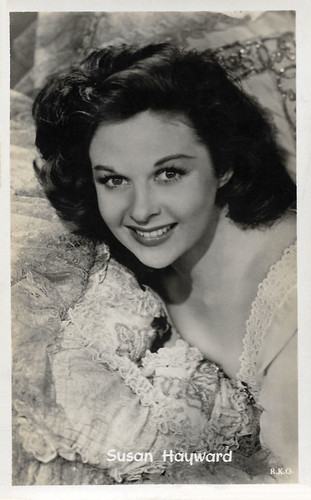
Belgian card. Photo: R.K.O.
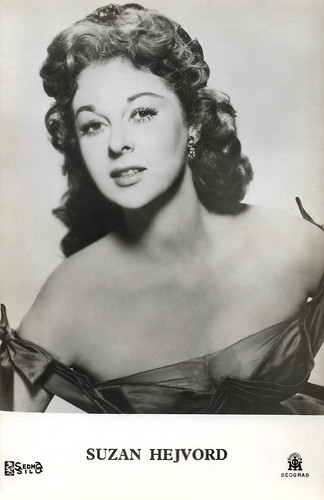
Yugoslavian postcard by Sedmo Silo / IOM, Beograd.
She played the part to the hilt
Two years later, Susan Hayward played Millie Perkins in the offbeat thriller Among the Living (Stuart Heisler, 1941). This quirky little film showed Hollywood Susan's considerable dramatic qualities for the first time.
She then played a Southern belle opposite John Wayne and Ray Milland in Cecil B. DeMille's Reap the Wild Wind (1942), one of the director's bigger successes, and once again showed her mettle as an actress.
Following that film she starred with Paulette Goddard and Fred MacMurray in The Forest Rangers (George Marshall, 1942), playing tough gal Tana Mason.
Although such films as Jack London (Alfred Santell, 1943), And Now Tomorrow (Irving Pichel, 1944) with Alan Ladd, and Deadline at Dawn (Harold Clurman, William Cameron Menzies, 1946) with Paul Lukas , continued to showcase her talent, she still hadn't gotten the meaty role she craved.
In 1947, however, she did, and received the first of five Academy Award nominations, this one for her portrayal of Angelica Evans in Smash-Up: The Story of a Woman (Stuart Heisler, 1947). She played the part to the hilt and many thought she would take home the Oscar, but she lost out to Loretta Young for The Farmer's Daughter (H.C. Potter, 1947).
In 1949 Susan was nominated again for My Foolish Heart (Mark Robson, 1949) and again was up against stiff competition, but once more her hopes were dashed when Olivia de Havilland won for The Heiress (William Wyler, 1949).
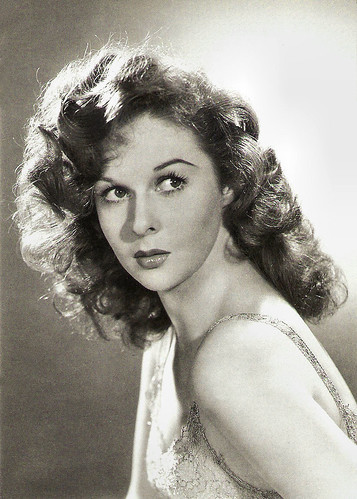
German postcard by edition cicero, Hamburg, no. 150/5. Photo: Hal McAlpine, 1941.

Belgian card, no. 850. Photo: R.K.O. Susan Hayward and Dana Andrews in My Foolish Heart (Mark Robson, 1949).
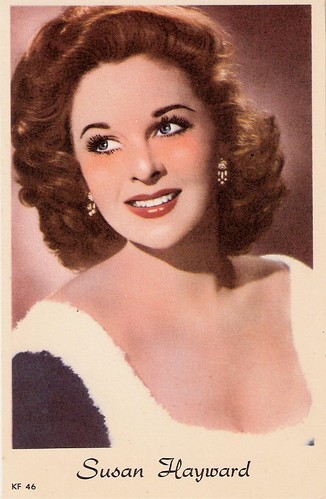
Vintage postcard, no. KF 46.
The performance of her lifetime
Now, with two Oscar nominations under her belt, Susan Hayward was a force to be reckoned with. Good scripts finally started to come her way and she chose carefully because she wanted to appear in good quality productions. Her caution paid off, as she garnered yet a third nomination in 1953 for With a Song in My Heart (Walter Lang, 1952).
Later that year she starred as Rachel Donaldson Robards Jackson in The President's Lady (Henry Levin, 1953) with Charlton Heston. She was superb as Andrew Jackson's embittered wife, who dies before he was able to take office as President of the United States.
After her fourth Academy Award nomination for I'll Cry Tomorrow (Daniel Mann, 1955), Susan began to wonder if she would ever take home the coveted gold statue. She didn't have much longer to wait, though.
In 1958 she gave the performance of her lifetime as real-life California killer Barbara Graham in I Want to Live! (Robert Wise, 1958), who was convicted of murder and sentenced to death in the gas chamber. Susan was absolutely riveting in her portrayal of the doomed woman. This time she was not only nominated for Best Actress, but won. After that role she appeared in about one film a year.
Thomas Mc Williams at IMDb : "Susan's personality is usually described as cold, icy, and aloof. She did not like socialising with crowds. She disliked homosexuals and effeminate men. Her taste in love ran strictly to the masculine, and both of her husbands were rugged Southerners. She loved sport fishing, and owned three ocean going boats for that purpose. Film directors enjoyed Susan's professionalism and her high standards. She was considered easy to work with, but she was not chummy after the cameras stopped."
In 1972 she made her last theatrical film, The Revengers (Daniel Mann, 1972), starring William Holden. A two-pack a day smoker with a taste for drink, Susan was diagnosed with brain cancer in March of 1972. The disease finally claimed her life in 1975 and she died at her Hollywood home. Susan Hayward was 57.
She was laid to rest in a grave adjacent that of her husband Floyd Eaton Chalkley in the peace of Carrollton, Georgia where they had spent several happy years together in life. Hayward had been married twice: first to actor Jess Barker from 1944 till their divorce in 1954. They had two children. With Floyd Eaton Chalkley, she was married from 1957 till his death in 1966.
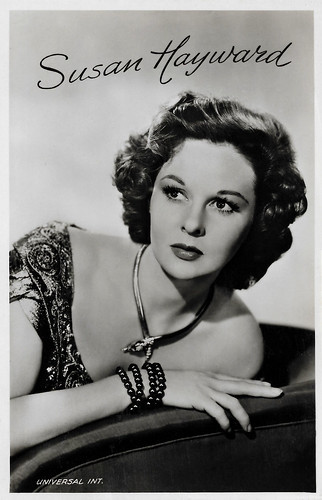
Belgian postcard, no. 3414. Photo: Universal Int.
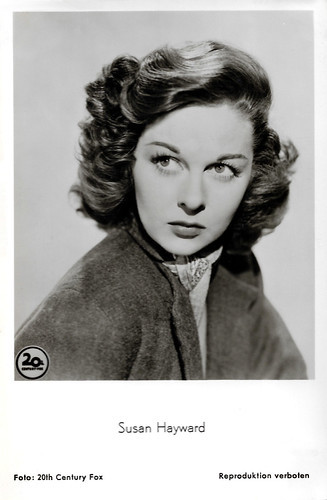
German postcard by F.J. Rüdel, Filmpostkartenverlag, Hamburg-Bergedorf, no. 148. Photo: 20th Century Fox.
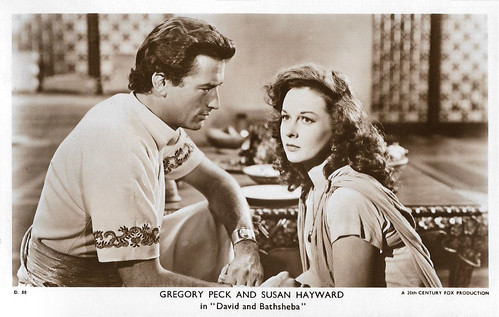
British postcard by The Picturegoer Series, London, no. D 88. Photo: 20th Century Fox. Gregory Peck and Susan Hayward in David and Bathsheba (Henry King, 1951).
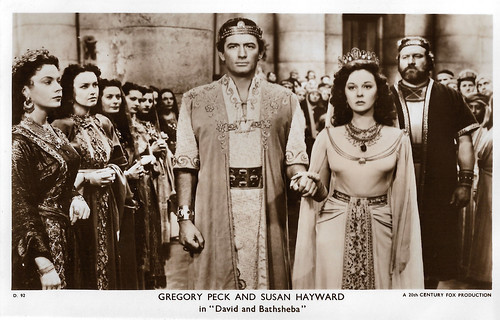
British postcard by The Picturegoer Series, London, no. D 92. Photo: 20th Century Fox. Gregory Peck and Susan Hayward in David and Bathsheba (Henry King, 1951).
Sources: (IMDb), (IMDb), Wikipedia and .

Dutch postcard by J.S.A. (J. Sleding, Amsterdam). Photo: Universal M.P.E.

Italian postcard by Rotalfoto, Milano, no. 41.

West-German postcard by Wilhelm-Schulze Witteborg (WS-Druck), Wanne-Eickel. Photo: Centfox. Susan Hayward in The Snows of Kilimanjaro (Henry King, 1952).
A life-long grudge
Susan Hayward was born Edythe Marrener in the Flatbush section of Brooklyn, New York, in 1917. Her father was a transportation worker.
The youngest of three children, she grew up in the shadow of her older sister Florence who was her mother's favourite. Edythe would nurse a life-long grudge over what she perceived as her mother's neglect.
She attended public school in Brooklyn, where she graduated from a commercial high school that was intended to give students a marketable skill. She had planned on becoming a secretary, but her plans changed. She started doing some modelling work for photographers in the NYC area.
By 1937, Edythe was brought to Hollywood as one of the hundreds of girls who had won a chance to screen test in the nationwide search for someone to play the role of Scarlett O'Hara in Margaret Mitchell's Gone with the Wind (Victor Fleming, 1939).
Although she lost out to Vivien Leigh , Susan was to carve her own signature in Hollywood circles. It would take several years of studio subsidised acting and voice lessons before her talent would emerge and she would be renamed Susan Hayward.
She got a bit part in Hollywood Hotel (Busby Berkeley, 1937). The bit parts continued all through 1938, with Susan playing, among other things, a coed, a telephone operator and an aspiring actress. She wasn't happy with these bit parts, but she also realised she had to "pay her dues".
In 1939 she finally landed a part with substance, playing Isobel Rivers in the hit action film Beau Geste (William A. Wellman, 1939) with Gary Cooper and Ray Milland .

Spanish postcard in the Hollywood (California) series by Belfo, no. 3790. Photo: Universal International.

Belgian card. Photo: R.K.O.

Yugoslavian postcard by Sedmo Silo / IOM, Beograd.
She played the part to the hilt
Two years later, Susan Hayward played Millie Perkins in the offbeat thriller Among the Living (Stuart Heisler, 1941). This quirky little film showed Hollywood Susan's considerable dramatic qualities for the first time.
She then played a Southern belle opposite John Wayne and Ray Milland in Cecil B. DeMille's Reap the Wild Wind (1942), one of the director's bigger successes, and once again showed her mettle as an actress.
Following that film she starred with Paulette Goddard and Fred MacMurray in The Forest Rangers (George Marshall, 1942), playing tough gal Tana Mason.
Although such films as Jack London (Alfred Santell, 1943), And Now Tomorrow (Irving Pichel, 1944) with Alan Ladd, and Deadline at Dawn (Harold Clurman, William Cameron Menzies, 1946) with Paul Lukas , continued to showcase her talent, she still hadn't gotten the meaty role she craved.
In 1947, however, she did, and received the first of five Academy Award nominations, this one for her portrayal of Angelica Evans in Smash-Up: The Story of a Woman (Stuart Heisler, 1947). She played the part to the hilt and many thought she would take home the Oscar, but she lost out to Loretta Young for The Farmer's Daughter (H.C. Potter, 1947).
In 1949 Susan was nominated again for My Foolish Heart (Mark Robson, 1949) and again was up against stiff competition, but once more her hopes were dashed when Olivia de Havilland won for The Heiress (William Wyler, 1949).

German postcard by edition cicero, Hamburg, no. 150/5. Photo: Hal McAlpine, 1941.

Belgian card, no. 850. Photo: R.K.O. Susan Hayward and Dana Andrews in My Foolish Heart (Mark Robson, 1949).

Vintage postcard, no. KF 46.
The performance of her lifetime
Now, with two Oscar nominations under her belt, Susan Hayward was a force to be reckoned with. Good scripts finally started to come her way and she chose carefully because she wanted to appear in good quality productions. Her caution paid off, as she garnered yet a third nomination in 1953 for With a Song in My Heart (Walter Lang, 1952).
Later that year she starred as Rachel Donaldson Robards Jackson in The President's Lady (Henry Levin, 1953) with Charlton Heston. She was superb as Andrew Jackson's embittered wife, who dies before he was able to take office as President of the United States.
After her fourth Academy Award nomination for I'll Cry Tomorrow (Daniel Mann, 1955), Susan began to wonder if she would ever take home the coveted gold statue. She didn't have much longer to wait, though.
In 1958 she gave the performance of her lifetime as real-life California killer Barbara Graham in I Want to Live! (Robert Wise, 1958), who was convicted of murder and sentenced to death in the gas chamber. Susan was absolutely riveting in her portrayal of the doomed woman. This time she was not only nominated for Best Actress, but won. After that role she appeared in about one film a year.
Thomas Mc Williams at IMDb : "Susan's personality is usually described as cold, icy, and aloof. She did not like socialising with crowds. She disliked homosexuals and effeminate men. Her taste in love ran strictly to the masculine, and both of her husbands were rugged Southerners. She loved sport fishing, and owned three ocean going boats for that purpose. Film directors enjoyed Susan's professionalism and her high standards. She was considered easy to work with, but she was not chummy after the cameras stopped."
In 1972 she made her last theatrical film, The Revengers (Daniel Mann, 1972), starring William Holden. A two-pack a day smoker with a taste for drink, Susan was diagnosed with brain cancer in March of 1972. The disease finally claimed her life in 1975 and she died at her Hollywood home. Susan Hayward was 57.
She was laid to rest in a grave adjacent that of her husband Floyd Eaton Chalkley in the peace of Carrollton, Georgia where they had spent several happy years together in life. Hayward had been married twice: first to actor Jess Barker from 1944 till their divorce in 1954. They had two children. With Floyd Eaton Chalkley, she was married from 1957 till his death in 1966.

Belgian postcard, no. 3414. Photo: Universal Int.

German postcard by F.J. Rüdel, Filmpostkartenverlag, Hamburg-Bergedorf, no. 148. Photo: 20th Century Fox.

British postcard by The Picturegoer Series, London, no. D 88. Photo: 20th Century Fox. Gregory Peck and Susan Hayward in David and Bathsheba (Henry King, 1951).

British postcard by The Picturegoer Series, London, no. D 92. Photo: 20th Century Fox. Gregory Peck and Susan Hayward in David and Bathsheba (Henry King, 1951).
Sources: (IMDb), (IMDb), Wikipedia and .
Published on September 19, 2019 22:00
September 18, 2019
Nana (1934)
Nana (Dorothy Arzner, George Fitzmaurice, 1934), starring Ukrainian-born Anna Sten, is an American film, produced by Samuel Goldwyn, and released through United Artists. This version of Émile Zola's famous novel was to be the vehicle for Sten's triumph as Samuel Goldwyn's trained, groomed and heavily promoted answer to Greta Garbo. Despite a record-breaking opening week at Radio City Music Hall, Sten was beautiful but disappointing.
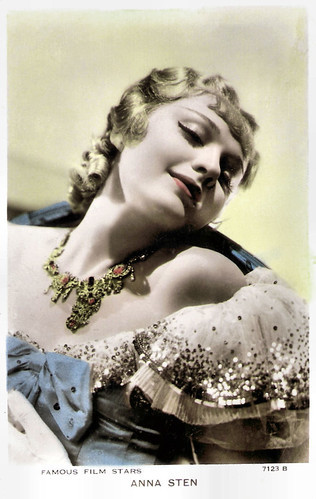
British postcard in the Famous Film Stars Series by Valentine's, no. 7123B. Photo: United Artists. Publicity still for Nana (Dorothy Arzner, George Fitzmaurice, 1934).
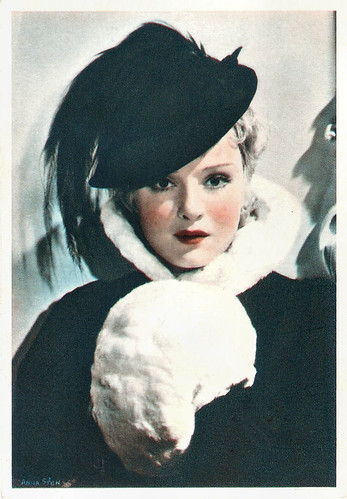
British postcard by De Reszke Cigarettes, no. 6. Photo: United Artists. Publicity still for Nana (Dorothy Arzner, George Fitzmaurice, 1934).
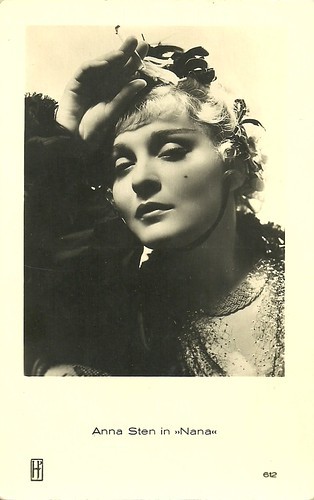
Dutch postcard by JosPe, Arnhem, no. 612. Anna Sten in Nana (Dorothy Arzner, George Fitzmaurice, 1934).
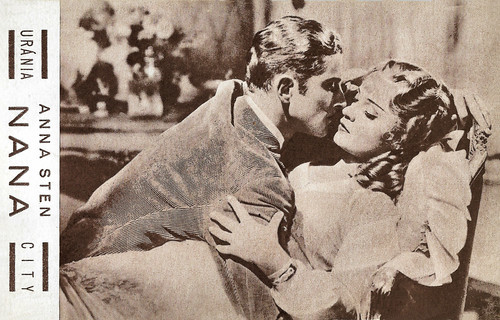
Hungarian postcard by Globus, Budapest. Photo: United Artists / City Film. Phillips Holmes and Anna Sten in Nana (Dorothy Arzner, George Fitzmaurice, 1934).
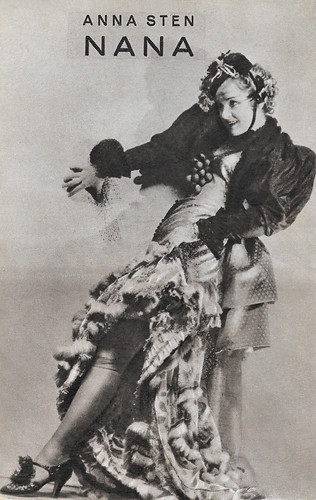
Hungarian postcard by Globus, Budapest. Photo: United Artists / City Film. Publicity still for Nana (Dorothy Arzner, George Fitzmaurice, 1934).
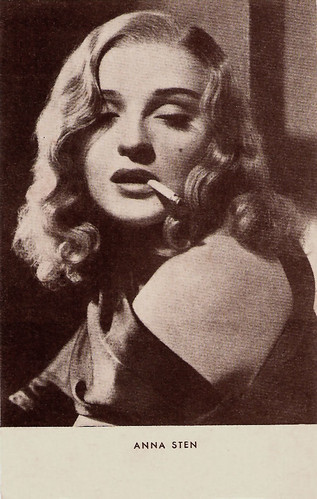
Portuguese postcard by Tip. Costa Sanches, Lisboa (Lisbon). Photo: publicity still for Nana (Dorothy Arzner, George Fitzmaurice, 1934).
A homogenised version of a scandalous novel
Her MGM contract up, the elusive Greta Garbo had returned to Sweden for several months during 1932-1933. Various Hollywood moguls tried to fill the gap by finding a "New Garbo". While she worked in Germany, Ukrainian-born actress Anna Sten came to the attention of Samuel Goldwyn. He decided to build her up as the rival of, and possible successor to Garbo.
For two years Goldwyn had his new star tutored in English and taught Hollywood screen acting methods. Goldwyn's tutoring of Sten is mentioned in Cole Porter's 1934 song 'Anything Goes' from the musical of the same name: "If Sam Goldwyn can with great conviction / Instruct Anna Sten in diction / Then Anna shows / Anything goes."
Her first American film was Nana (1934), directed by Dorothy Arzner and George Fitzmaurice. Fitzmaurice was fired and replaced by Arzner. Her co-stars were Lionel Atwill, Richard Bennett, Mae Clarke and Philips Holmes. Nana was a somewhat homogenised version of Emile Zola's scandalous novel.
In 1860s Paris, beautiful Nana is the toast of the Paris theatre. She falls in love with handsome lieutenant George Muffat (Phillips Holmes). When his older brother colonel Andre (Lionel Atwill) finds out that Nana is also the mistress of the elderly impresario Gaston Greiner (Richard Bennett), he forbids his brother to marry her, but then Andre falls for her himself.
Wes Connors at IMDb : "Sten, who had already proved herself an accomplished and versatile actress, comes across as unable to handle the lead role. A good supporting cast, fine photography from Gregg Toland, and capable direction by Dorothy Arzner failed to create anything approaching Garbo or Dietrich. Ironically, Garbo's own Camille (1936) would later cover much of the territory attempted in Nana."
Tracy Figueira at IMDb : "The problem is that there was no way Hollywood in 1934 could do justice to Emile Zola's scathing account of sexual debauchery in Second Empire Paris. The nudity is gone, most of the lovers are gone, the lesbian relationship with Satin (Mae Clarke) is barely hinted at. Nana, as played by Sten, is a far more sympathetic character than she is in the book. She shoots herself rather than rotting to death from smallpox (a euphemism for syphilis?) No mention is made of her illegitimate child or the path of death and destruction she leaves in her wake. The film is an interesting if dated curio, worth watching at least once, but proof that not every film from Hollywood's 'Golden Age' is a gem."
Nana was a box office disappointment, as were Anna Sten 's two subsequent Goldwyn films, We Live Again (Rouben Mamoulian, 1934) and The Wedding Night (King Vidor, 1935) with Gary Cooper. Reluctantly, Goldwyn dissolved his contract with his ‘new Garbo'.
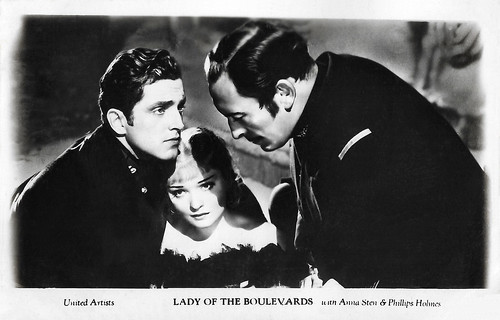
British postcard in the Filmshots series by Film Weekly. Photo: United Artists. Philips Holmes, Anna Sten and Lionel Atwell in Nana (Dorothy Arzner, George Fitzmaurice, 1934). Lady of the Boulevards was the British title of Nana.
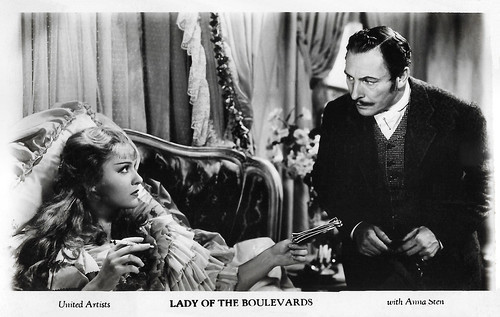
British postcard in the Filmshots series by Film Weekly. Photo: United Artists. Anna Sten and Lionel Atwell in Nana (Dorothy Arzner, George Fitzmaurice, 1934). Lady of the Boulevards was the British title of Nana.
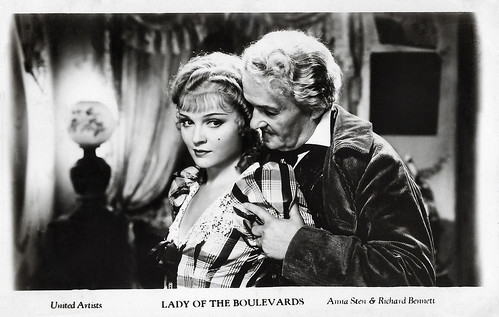
British postcard in the Filmshots series by Film Weekly. Photo: United Artists. Anna Sten and Richard Bennett in Nana (Dorothy Arzner, George Fitzmaurice, 1934).
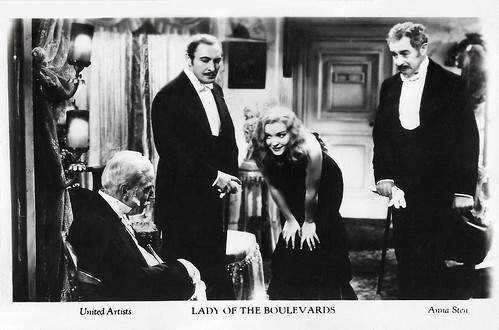
British postcard in the Filmshots series by Film Weekly. Photo: United Artists. Lionel Atwell, Anna Sten and Richard Bennett in Nana (Dorothy Arzner, George Fitzmaurice, 1934).
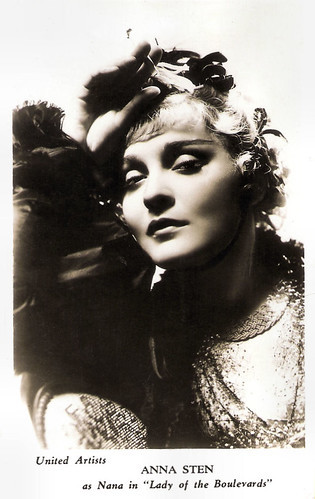
British card. Photo: United Artists. Publicity still for Nana (Dorothy Arzner, George Fitzmaurice, 1934). Lady of the Boulevards was the British title of Nana.
Sources: Wikipedia and IMDb.

British postcard in the Famous Film Stars Series by Valentine's, no. 7123B. Photo: United Artists. Publicity still for Nana (Dorothy Arzner, George Fitzmaurice, 1934).

British postcard by De Reszke Cigarettes, no. 6. Photo: United Artists. Publicity still for Nana (Dorothy Arzner, George Fitzmaurice, 1934).

Dutch postcard by JosPe, Arnhem, no. 612. Anna Sten in Nana (Dorothy Arzner, George Fitzmaurice, 1934).

Hungarian postcard by Globus, Budapest. Photo: United Artists / City Film. Phillips Holmes and Anna Sten in Nana (Dorothy Arzner, George Fitzmaurice, 1934).

Hungarian postcard by Globus, Budapest. Photo: United Artists / City Film. Publicity still for Nana (Dorothy Arzner, George Fitzmaurice, 1934).

Portuguese postcard by Tip. Costa Sanches, Lisboa (Lisbon). Photo: publicity still for Nana (Dorothy Arzner, George Fitzmaurice, 1934).
A homogenised version of a scandalous novel
Her MGM contract up, the elusive Greta Garbo had returned to Sweden for several months during 1932-1933. Various Hollywood moguls tried to fill the gap by finding a "New Garbo". While she worked in Germany, Ukrainian-born actress Anna Sten came to the attention of Samuel Goldwyn. He decided to build her up as the rival of, and possible successor to Garbo.
For two years Goldwyn had his new star tutored in English and taught Hollywood screen acting methods. Goldwyn's tutoring of Sten is mentioned in Cole Porter's 1934 song 'Anything Goes' from the musical of the same name: "If Sam Goldwyn can with great conviction / Instruct Anna Sten in diction / Then Anna shows / Anything goes."
Her first American film was Nana (1934), directed by Dorothy Arzner and George Fitzmaurice. Fitzmaurice was fired and replaced by Arzner. Her co-stars were Lionel Atwill, Richard Bennett, Mae Clarke and Philips Holmes. Nana was a somewhat homogenised version of Emile Zola's scandalous novel.
In 1860s Paris, beautiful Nana is the toast of the Paris theatre. She falls in love with handsome lieutenant George Muffat (Phillips Holmes). When his older brother colonel Andre (Lionel Atwill) finds out that Nana is also the mistress of the elderly impresario Gaston Greiner (Richard Bennett), he forbids his brother to marry her, but then Andre falls for her himself.
Wes Connors at IMDb : "Sten, who had already proved herself an accomplished and versatile actress, comes across as unable to handle the lead role. A good supporting cast, fine photography from Gregg Toland, and capable direction by Dorothy Arzner failed to create anything approaching Garbo or Dietrich. Ironically, Garbo's own Camille (1936) would later cover much of the territory attempted in Nana."
Tracy Figueira at IMDb : "The problem is that there was no way Hollywood in 1934 could do justice to Emile Zola's scathing account of sexual debauchery in Second Empire Paris. The nudity is gone, most of the lovers are gone, the lesbian relationship with Satin (Mae Clarke) is barely hinted at. Nana, as played by Sten, is a far more sympathetic character than she is in the book. She shoots herself rather than rotting to death from smallpox (a euphemism for syphilis?) No mention is made of her illegitimate child or the path of death and destruction she leaves in her wake. The film is an interesting if dated curio, worth watching at least once, but proof that not every film from Hollywood's 'Golden Age' is a gem."
Nana was a box office disappointment, as were Anna Sten 's two subsequent Goldwyn films, We Live Again (Rouben Mamoulian, 1934) and The Wedding Night (King Vidor, 1935) with Gary Cooper. Reluctantly, Goldwyn dissolved his contract with his ‘new Garbo'.

British postcard in the Filmshots series by Film Weekly. Photo: United Artists. Philips Holmes, Anna Sten and Lionel Atwell in Nana (Dorothy Arzner, George Fitzmaurice, 1934). Lady of the Boulevards was the British title of Nana.

British postcard in the Filmshots series by Film Weekly. Photo: United Artists. Anna Sten and Lionel Atwell in Nana (Dorothy Arzner, George Fitzmaurice, 1934). Lady of the Boulevards was the British title of Nana.

British postcard in the Filmshots series by Film Weekly. Photo: United Artists. Anna Sten and Richard Bennett in Nana (Dorothy Arzner, George Fitzmaurice, 1934).

British postcard in the Filmshots series by Film Weekly. Photo: United Artists. Lionel Atwell, Anna Sten and Richard Bennett in Nana (Dorothy Arzner, George Fitzmaurice, 1934).

British card. Photo: United Artists. Publicity still for Nana (Dorothy Arzner, George Fitzmaurice, 1934). Lady of the Boulevards was the British title of Nana.
Sources: Wikipedia and IMDb.
Published on September 18, 2019 22:00
September 17, 2019
Pablito Calvo
Pablito Calvo (1948–2000) was a Spanish child actor. After the international success of Marcelino, pan y vino/Marcelino Bread And Wine (1955), he became a star. At the age of 16, he retired.

Italian postcard by Rotalfoto, Milano, no. 744.
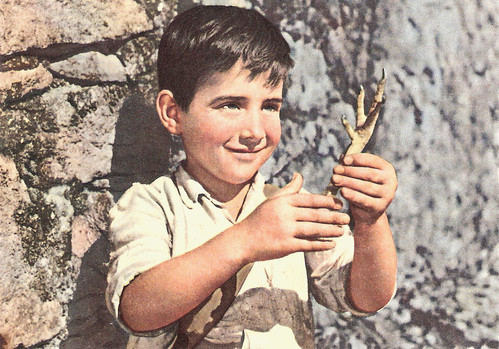
Italian postcard by Ed. Villaggio del Fanciullo, Bologna. Photo: E.N.I.C. Publicity still for Marcelino, pan y vino/Marcelino Bread And Wine (1955).
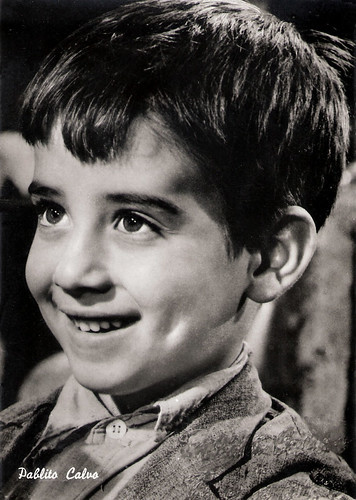
Italian postcard by Bromofoto, Milano, no. 1180. Photo: Enic Falco Film. Pablito Calvo in Mi tío Jacinto/Pepote (Ladislao Vajda, 1956).
An orphan in a Monastery
Pablito Calvo was born as Pablo Calvo Hidalgo in Madrid, Spain in 1948.
At the age of 8, he played the lead role in Marcelino, pan y vino/The Miracle of Marcelino (Ladislao Vajda, 1955). The film was written by José María Sánchez Silva, who based it on his novel, and directed by Ladislao Vajda.
Pablito plays the orphan Marcelino who grows up in a monastery. One day when he eats his small meal in a room full of old things he gives a piece of his bread to an old wooden Jesus figure - and indeed it takes the bread and eats it. At the 1955 Cannes Film Festival the film won an award, and at the 5th Berlin International Film Festival it won the Silver Bear.
Pablito, who had received a special mention from the Cannes festival jury, became Spain's most famous child actor. The following year he appeared in Mi tío Jacinto/Pepote (Ladislao Vajda, 1956) which won the Golden Bear (Audience Award) at the Berlin International Film Festival.
Hal Erickson notes at AllMovie : “Though Pepote is hardly upbeat entertainment, the relaxed, natural performance of newcomer Pablito Calvo brightens every scene he's in.”
A year later followed Un ángel se paseó por Brooklyn/An Angel Over Brooklyn (Ladislao Vajda, 1957) with Peter Ustinov as a nasty, grasping Brooklyn slum lord who turns into a dog. Pablito also filmed in Italy, where he appeared with comedian Totò in Totò e Marcellino/Toto and Marcellino (Antonio Musu, 1958).
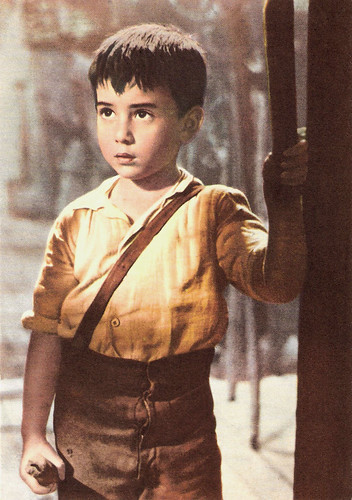
Italian postcard by Ed. Villaggio del Fanciullo, Bologna. Photo: E.N.I.C. Publicity still for Marcelino, pan y vino/The Miracle of Marcelino (Ladislao Vajda, 1955).
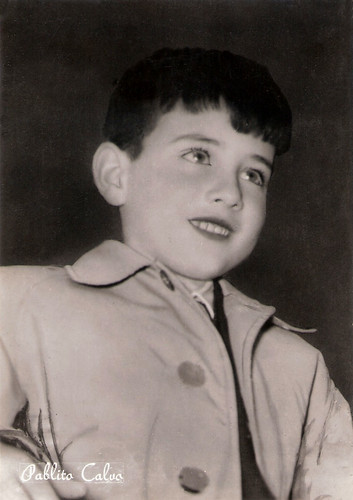
Vintage postcard.
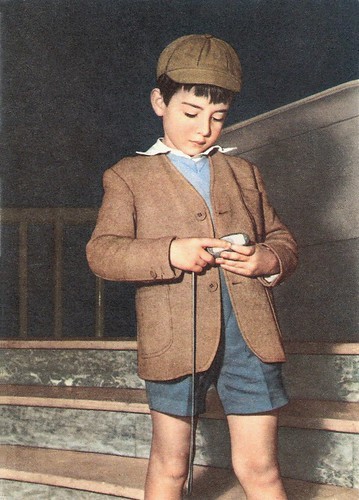
Italian postcard by Ed. Villaggio del Fanciullo, Bologna.
Mexican Revolution
During the early 1960s, Pablito Calvo starred in Juanito (Fernando Palacios, 1960) with Georg Thomalla , Alerta en el cielo/Alert in the sky (Luis César Amadori, 1961) with Antonio Vilar, Dos años de vacaciones/Shipwreck Island (Emilio Gómez Muriel, 1962) based on a story by Jules Verne, and Barcos de papel/Paper Boats (Román Viñoly Barreto, 1963).
Calvo sang in a few films, but his singing voice was always dubbed on screen, in Spain by a woman, Matilde F. Vilariño.
In 1963, he retired from acting at the age of 16 to become an industrial engineer. Later, he worked in tourism and promoting buildings in Torrevieja.
Pablito Calvo died of a brain hemorrhage in 2000 in Alicante, Spain. He was aged 52. He had been married to Juana Olmedo since 1976.
Pablito’s successful debut, Marcelino pan y vino, was remade several times. A Philippine remake, May Bukas Pa, was released in 1979. An Italian remake, Marcellino, was produced in 1991 in colour. And also a Mexican remake was made in 2010, with the basic storyline and framed by the Mexican Revolution of 1910.
The original version remains one of the most famous and successful Spanish films ever made in history, and one of the first Spanish films to become successful in the U.S. as well.
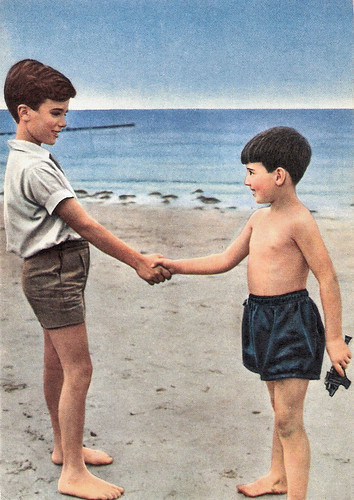
Michel Ray and Pablito Calvo. Italian postcard by Ed. Villaggio del Fanciullo, Bologna.
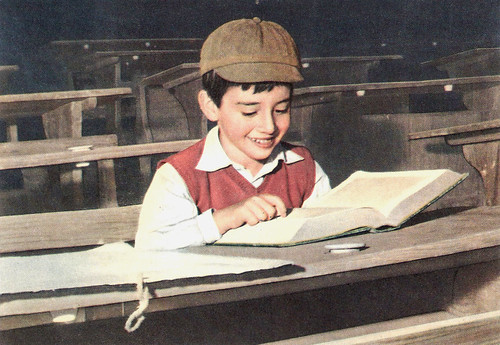
Italian postcard by Ed. Villaggio del Fanciullo, Bologna.
American trailer Marcelino, pan y vino/The Miracle of Marcelino (1955). Source: Jose Mattioli (YouTube).
Scene from Mi Tío Jacinto/Pepote (1956). Source: Alfie1982Alfie (YouTube).
Sources: Hal Erickson (AllMovie), Wikipedia and .

Italian postcard by Rotalfoto, Milano, no. 744.

Italian postcard by Ed. Villaggio del Fanciullo, Bologna. Photo: E.N.I.C. Publicity still for Marcelino, pan y vino/Marcelino Bread And Wine (1955).

Italian postcard by Bromofoto, Milano, no. 1180. Photo: Enic Falco Film. Pablito Calvo in Mi tío Jacinto/Pepote (Ladislao Vajda, 1956).
An orphan in a Monastery
Pablito Calvo was born as Pablo Calvo Hidalgo in Madrid, Spain in 1948.
At the age of 8, he played the lead role in Marcelino, pan y vino/The Miracle of Marcelino (Ladislao Vajda, 1955). The film was written by José María Sánchez Silva, who based it on his novel, and directed by Ladislao Vajda.
Pablito plays the orphan Marcelino who grows up in a monastery. One day when he eats his small meal in a room full of old things he gives a piece of his bread to an old wooden Jesus figure - and indeed it takes the bread and eats it. At the 1955 Cannes Film Festival the film won an award, and at the 5th Berlin International Film Festival it won the Silver Bear.
Pablito, who had received a special mention from the Cannes festival jury, became Spain's most famous child actor. The following year he appeared in Mi tío Jacinto/Pepote (Ladislao Vajda, 1956) which won the Golden Bear (Audience Award) at the Berlin International Film Festival.
Hal Erickson notes at AllMovie : “Though Pepote is hardly upbeat entertainment, the relaxed, natural performance of newcomer Pablito Calvo brightens every scene he's in.”
A year later followed Un ángel se paseó por Brooklyn/An Angel Over Brooklyn (Ladislao Vajda, 1957) with Peter Ustinov as a nasty, grasping Brooklyn slum lord who turns into a dog. Pablito also filmed in Italy, where he appeared with comedian Totò in Totò e Marcellino/Toto and Marcellino (Antonio Musu, 1958).

Italian postcard by Ed. Villaggio del Fanciullo, Bologna. Photo: E.N.I.C. Publicity still for Marcelino, pan y vino/The Miracle of Marcelino (Ladislao Vajda, 1955).

Vintage postcard.

Italian postcard by Ed. Villaggio del Fanciullo, Bologna.
Mexican Revolution
During the early 1960s, Pablito Calvo starred in Juanito (Fernando Palacios, 1960) with Georg Thomalla , Alerta en el cielo/Alert in the sky (Luis César Amadori, 1961) with Antonio Vilar, Dos años de vacaciones/Shipwreck Island (Emilio Gómez Muriel, 1962) based on a story by Jules Verne, and Barcos de papel/Paper Boats (Román Viñoly Barreto, 1963).
Calvo sang in a few films, but his singing voice was always dubbed on screen, in Spain by a woman, Matilde F. Vilariño.
In 1963, he retired from acting at the age of 16 to become an industrial engineer. Later, he worked in tourism and promoting buildings in Torrevieja.
Pablito Calvo died of a brain hemorrhage in 2000 in Alicante, Spain. He was aged 52. He had been married to Juana Olmedo since 1976.
Pablito’s successful debut, Marcelino pan y vino, was remade several times. A Philippine remake, May Bukas Pa, was released in 1979. An Italian remake, Marcellino, was produced in 1991 in colour. And also a Mexican remake was made in 2010, with the basic storyline and framed by the Mexican Revolution of 1910.
The original version remains one of the most famous and successful Spanish films ever made in history, and one of the first Spanish films to become successful in the U.S. as well.

Michel Ray and Pablito Calvo. Italian postcard by Ed. Villaggio del Fanciullo, Bologna.

Italian postcard by Ed. Villaggio del Fanciullo, Bologna.
American trailer Marcelino, pan y vino/The Miracle of Marcelino (1955). Source: Jose Mattioli (YouTube).
Scene from Mi Tío Jacinto/Pepote (1956). Source: Alfie1982Alfie (YouTube).
Sources: Hal Erickson (AllMovie), Wikipedia and .
Published on September 17, 2019 22:00
September 16, 2019
Wehe, wenn sie losgelassen...! (1926)
In the film comedy Wehe, wenn sie losgelassen...!/When She Starts - Look Out! (1926), Henny Porten played once again a double role. The film was a parody on hypermodern women. Carl Froelich was the director and the film was produced by Henny Porten-Froehlich-Produktion.
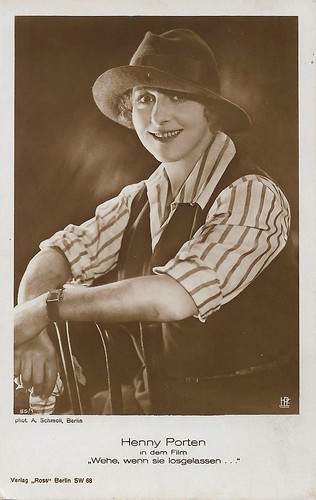
German postcard by Ross Verlag, no. 55/1. Photo: A. Schmoll, Berlin / Henny Porten Film. Henny Porten in Wehe, wenn sie losgelassen...!/When She Starts - Look Out! (Carl Froehlich, 1926).
A good-looking bourgeois housewife and an ugly countryside girl
Just like she had done before in Kohlhiesels Töchter (Ernst Lubitsch, 1920), Henny Porten again played two parts in Wehe, wenn sie losgelassen...!/When She Starts - Look Out! (Carl Froelich, 1926): that of a good-looking bourgeois housewife, Cecilia Angeropp, and that of an ugly countryside girl, Liesl, the maid of the other.
Porten said herself about this: "I have always had a special preference for double-roles. It was not the masquerades that were particularly appealing to me but the psychological aspects:
I wanted to portray two completely different characters to the point that the spectator would as long as possible keep the illusion of both roles being played by two different actresses." (Quoted in Christiane Schönefeld ed., Processes of Transposition: German Literature and Film, 2007).
The two-shots with both characters within the same shot (see the fifth postcard in this post) were obtained with double exposure.
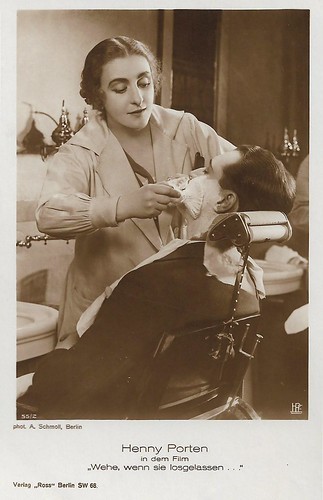
German postcard by Ross Verlag, no. 55/2. Photo: A. Schmoll, Berlin / Henny Porten Film. Henny Porten and Angelo Ferrari in Wehe, wenn sie losgelassen...!/When She Starts - Look Out! (Carl Froehlich, 1926).
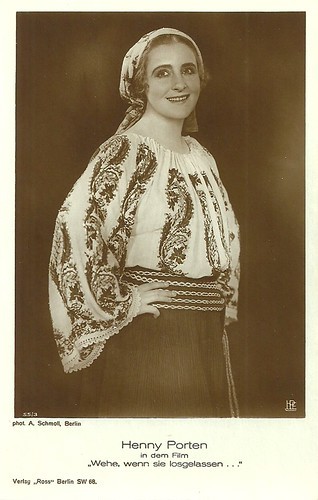
German postcard by Ross Verlag, no. 55/3. Photo: A. Schmoll, Berlin / Henny Porten Film. Henny Porten in Wehe, wenn sie losgelassen...!/When She Starts - Look Out! (Carl Froehlich, 1926).
The world cannot move without her
While the usual online sites don't give a content description, the Dutch historical newspaper site Delpher mentions one, when the film was reprised in 1928 at the Amsterdam cinema Corso, under the title of Vrouwenlist (A Woman's Ruse):
"The film is intended as a parody on hypermodern women. Henny Porten plays the part of Mrs. Cecilia Angeropp, wife of a wealthy merchant. As a modern woman, she thinks the world cannot move without her but is incapable to make things right. Her husband lets her feel how foolish she is." (Voorwaarts, sociaal-democratisch dagblad, 25-02-1928).
When first shown in the Netherlands in 1926 under the title Moderne Vrouwen (Modern Women), the newspaper Het Vaderland thought, the mocking of modern women was a bit unreasonable, but because of the truly good humor there was no real harm in it.
While the play of the husband by Bruno Kastner was considered a bit flat, Curt Bois's'performance as the third person in this love triangle was considered excellent. (Het Vaderland, 20-11-1926).
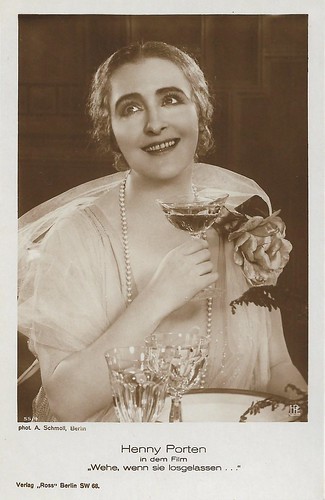
German postcard by Ross Verlag, no. 55/4. Photo: A. Schmoll, Berlin / Henny Porten Film. Henny Porten in Wehe, wenn sie losgelassen...!/When She Starts - Look Out! (Carl Froehlich, 1926).
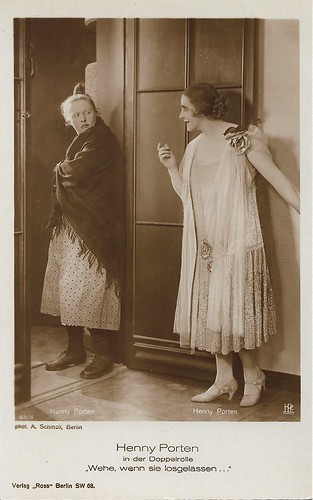
German postcard by Ross Verlag, no. 55/5. Photo: A. Schmoll, Berlin / Henny Porten Film. Henny Porten in Wehe, wenn sie losgelassen...!/When She Starts - Look Out! (Carl Froehlich, 1926).
Sourceas: Voorwaarts (Dutch), Het Vaderland (Dutch), Filmportal.de and IMDb.

German postcard by Ross Verlag, no. 55/1. Photo: A. Schmoll, Berlin / Henny Porten Film. Henny Porten in Wehe, wenn sie losgelassen...!/When She Starts - Look Out! (Carl Froehlich, 1926).
A good-looking bourgeois housewife and an ugly countryside girl
Just like she had done before in Kohlhiesels Töchter (Ernst Lubitsch, 1920), Henny Porten again played two parts in Wehe, wenn sie losgelassen...!/When She Starts - Look Out! (Carl Froelich, 1926): that of a good-looking bourgeois housewife, Cecilia Angeropp, and that of an ugly countryside girl, Liesl, the maid of the other.
Porten said herself about this: "I have always had a special preference for double-roles. It was not the masquerades that were particularly appealing to me but the psychological aspects:
I wanted to portray two completely different characters to the point that the spectator would as long as possible keep the illusion of both roles being played by two different actresses." (Quoted in Christiane Schönefeld ed., Processes of Transposition: German Literature and Film, 2007).
The two-shots with both characters within the same shot (see the fifth postcard in this post) were obtained with double exposure.

German postcard by Ross Verlag, no. 55/2. Photo: A. Schmoll, Berlin / Henny Porten Film. Henny Porten and Angelo Ferrari in Wehe, wenn sie losgelassen...!/When She Starts - Look Out! (Carl Froehlich, 1926).

German postcard by Ross Verlag, no. 55/3. Photo: A. Schmoll, Berlin / Henny Porten Film. Henny Porten in Wehe, wenn sie losgelassen...!/When She Starts - Look Out! (Carl Froehlich, 1926).
The world cannot move without her
While the usual online sites don't give a content description, the Dutch historical newspaper site Delpher mentions one, when the film was reprised in 1928 at the Amsterdam cinema Corso, under the title of Vrouwenlist (A Woman's Ruse):
"The film is intended as a parody on hypermodern women. Henny Porten plays the part of Mrs. Cecilia Angeropp, wife of a wealthy merchant. As a modern woman, she thinks the world cannot move without her but is incapable to make things right. Her husband lets her feel how foolish she is." (Voorwaarts, sociaal-democratisch dagblad, 25-02-1928).
When first shown in the Netherlands in 1926 under the title Moderne Vrouwen (Modern Women), the newspaper Het Vaderland thought, the mocking of modern women was a bit unreasonable, but because of the truly good humor there was no real harm in it.
While the play of the husband by Bruno Kastner was considered a bit flat, Curt Bois's'performance as the third person in this love triangle was considered excellent. (Het Vaderland, 20-11-1926).

German postcard by Ross Verlag, no. 55/4. Photo: A. Schmoll, Berlin / Henny Porten Film. Henny Porten in Wehe, wenn sie losgelassen...!/When She Starts - Look Out! (Carl Froehlich, 1926).

German postcard by Ross Verlag, no. 55/5. Photo: A. Schmoll, Berlin / Henny Porten Film. Henny Porten in Wehe, wenn sie losgelassen...!/When She Starts - Look Out! (Carl Froehlich, 1926).
Sourceas: Voorwaarts (Dutch), Het Vaderland (Dutch), Filmportal.de and IMDb.
Published on September 16, 2019 22:00
September 15, 2019
Ica Lenkeffy
Ica Lenkeffy a.k.a. Ica von Lenkeffy (1896-1955) was a Hungarian actress of the stage and screen, who was most active in Hungarian silent cinema in the late 1910s and early 1920s. She also made some films in Austria, Germany, and France.
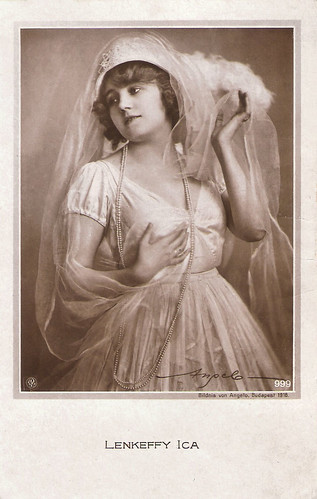
German postcard by NPG, no. 999. Photo: Angelo, Budapest, 1918.
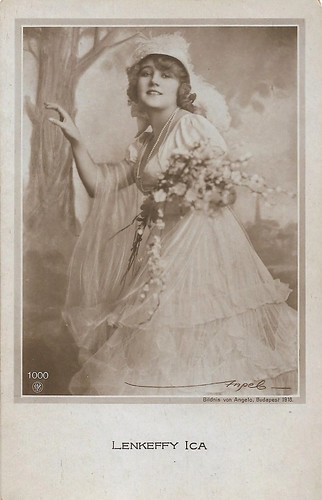
German postcard by NPG, no. 1000. Photo: Angelo, Budapest, 1918.
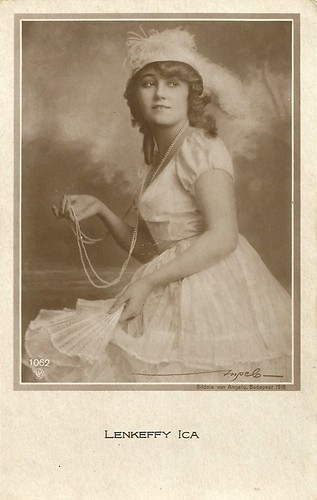
German postcard. NPG, no. 1062. Photo Angelo, Budapest 1918.
Summer Love
Ica (von) Lenkeffy was born in 1896, in Miskolc, Hungary. She was the daughter of actor Kornél Lenkefi (originally Manó József Győző Kaukal) and Ernesztin (Catherine) Kaukal, so her real name was Ilona Kaukál.
Lenkeffy attended school in Budapest but did not complete drama school. She first appeared in the countryside, and at the age of fifteen introduced herself in the role of Julie in 'Summer Love' at Vígszínház (the Comedy Theatre of Budapest).
Until 1913, she was a member of the Vígszínház, then worked from 1914 at the Hungarian Theatre, and in 1915 she became a member of the Royal Theatre. In 1918, she married Imre Roboz, the director of the company Projectograf in Budapest, but they divorced in 1923.
Ica Lenkeffy started in film in 1912 with director Sándor (Alexander) Góth, who had just started his career. Her first successful film was Szulamit (1916, directed by Jenő Illés (Eugen Illés), set in Old Testaments times and with Dezsõ Kertész as her co-star.
Lenkeffy then mostly played in films directed by Márkus László, Bela Balogh, Mihály Kertész (Michael Curtiz) and Sándor (Alexander) Korda. Among her film partners were Alfréd Deésy, Oscar Beregi Sr. , Gyula Csortos, Mihály Várkonyi ( Victor Varconi ), Artúr Somlay, Jenő Törzs, Svetislav Petrovic (Iván Petrovich), and the later Oscar winner Pál Lukács ( Paul Lukas ).
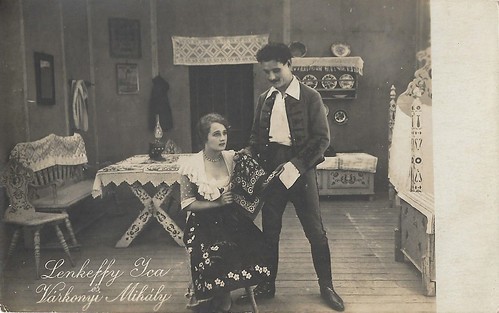
Hungarian postcard. Photo: Corvin Film. Ica Lenkeffy and Mihály Várkonyi (Victor Varconi) in A csikós (M. Miklós Pásztory, 1917).
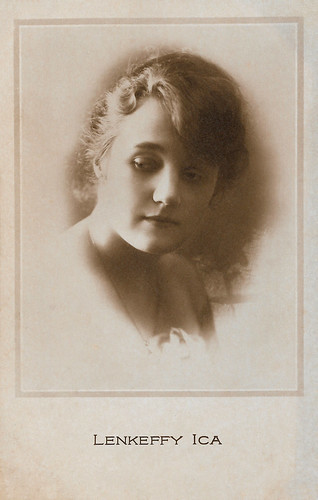
Hungarian postcard by Jòzsef Reinitz, Budapest.
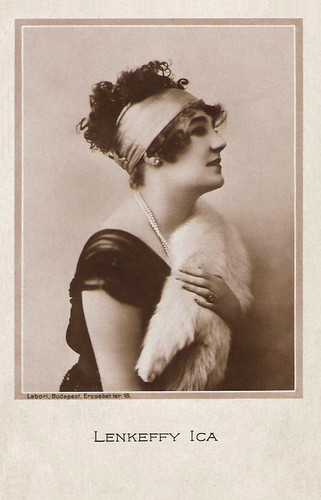
Hungarian postcard by József Reinitz, Budapest. Photo: Miklós Labori, Budapest.
Living in Luxury
In 1921 Ica Lenkeffy moved to Vienna for acting in films there, e.g. in Boccaccio (Michael Curtiz, 1920), also with Paul Lukas .
She then moved on to Berlin, where she e.g. starred opposite Paul Hartmann in the May-Film production Die Erbin von Tordis (Robert Dinesen, 1921). In the German production of Othello (Dimitri Buchowetzki, 1922), Ica (by now von) Lenkeffy played Desdemona opposite Emil Jannings as Othello and Werner Krauss as Jago.
In 1923 Lenkeffy married again, this time to Parisian banker Louis Mannheim. She moved to Paris with him, where she lived in luxury, but left the cinema at her husband's request.
In the late 1920s she tried to return and appeared in two French silent films, Yvette (Alberto Cavalcanti, 1928) and Souris d'hôtel (Adelqui Migliar, 1929) - she had the lead in the latter film.
The advent of sound cinema made any follow-ups impossible. She then escaped her husband with Miklós Goldberger, son of industrial magnate Leo von Goldberger de Buday.
In the 1930s Lenkeffy returned to Hungary, where she died in 1955, in Budapest.
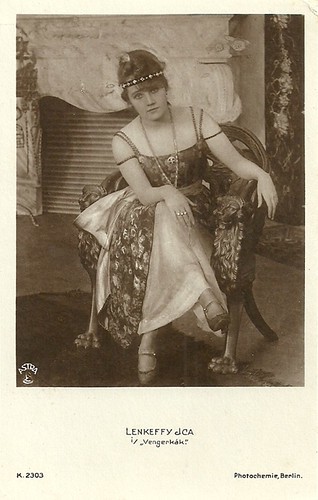
German postcard by Photochemie, Berlin, no. K.2303. Photo: Astra Film. Ica Lenkeffy in the Hungarian silent film Vengerkák (Béla Balogh, 1917), based on a play by Sándor Góth.
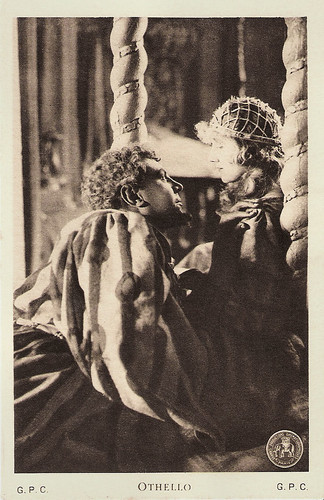
French postcard by Edition de la Cinematographie Française. Photo: Grandes Productions Cinématographiques (G.P.C.). Emil Jannings and Ica von Lenkeffy in Othello (Dimitri Buchowetzki, 1922).
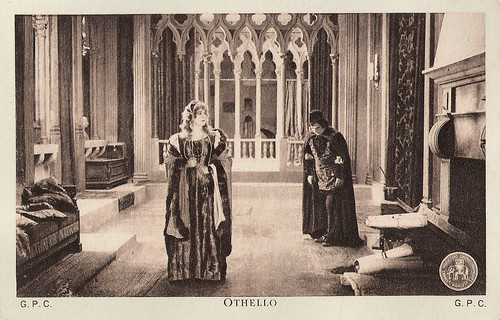
French postcard by Edition de la Cinematographie Française. Photo: Grandes Productions Cinématographiques (G.P.C.). Photo: publicity still for Othello (Dimitri Buchowetzki, 1922) with Ica von Lenkeffy and Theodor Loos .
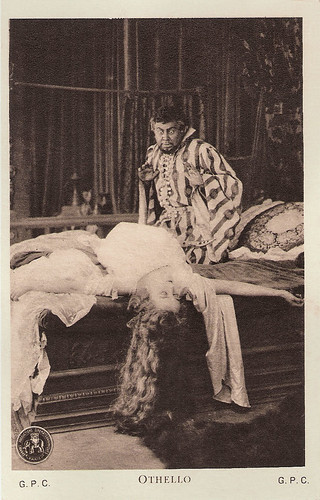
French postcard by Edition de la Cinematographie Française. Photo: Grandes Productions Cinématographiques (G.P.C.). Emil Jannings and Ica von Lenkeffy in Othello (Dimitri Buchowetzki, 1922).
Sources: Wikipedia (Hungarian and English) and .

German postcard by NPG, no. 999. Photo: Angelo, Budapest, 1918.

German postcard by NPG, no. 1000. Photo: Angelo, Budapest, 1918.

German postcard. NPG, no. 1062. Photo Angelo, Budapest 1918.
Summer Love
Ica (von) Lenkeffy was born in 1896, in Miskolc, Hungary. She was the daughter of actor Kornél Lenkefi (originally Manó József Győző Kaukal) and Ernesztin (Catherine) Kaukal, so her real name was Ilona Kaukál.
Lenkeffy attended school in Budapest but did not complete drama school. She first appeared in the countryside, and at the age of fifteen introduced herself in the role of Julie in 'Summer Love' at Vígszínház (the Comedy Theatre of Budapest).
Until 1913, she was a member of the Vígszínház, then worked from 1914 at the Hungarian Theatre, and in 1915 she became a member of the Royal Theatre. In 1918, she married Imre Roboz, the director of the company Projectograf in Budapest, but they divorced in 1923.
Ica Lenkeffy started in film in 1912 with director Sándor (Alexander) Góth, who had just started his career. Her first successful film was Szulamit (1916, directed by Jenő Illés (Eugen Illés), set in Old Testaments times and with Dezsõ Kertész as her co-star.
Lenkeffy then mostly played in films directed by Márkus László, Bela Balogh, Mihály Kertész (Michael Curtiz) and Sándor (Alexander) Korda. Among her film partners were Alfréd Deésy, Oscar Beregi Sr. , Gyula Csortos, Mihály Várkonyi ( Victor Varconi ), Artúr Somlay, Jenő Törzs, Svetislav Petrovic (Iván Petrovich), and the later Oscar winner Pál Lukács ( Paul Lukas ).

Hungarian postcard. Photo: Corvin Film. Ica Lenkeffy and Mihály Várkonyi (Victor Varconi) in A csikós (M. Miklós Pásztory, 1917).

Hungarian postcard by Jòzsef Reinitz, Budapest.

Hungarian postcard by József Reinitz, Budapest. Photo: Miklós Labori, Budapest.
Living in Luxury
In 1921 Ica Lenkeffy moved to Vienna for acting in films there, e.g. in Boccaccio (Michael Curtiz, 1920), also with Paul Lukas .
She then moved on to Berlin, where she e.g. starred opposite Paul Hartmann in the May-Film production Die Erbin von Tordis (Robert Dinesen, 1921). In the German production of Othello (Dimitri Buchowetzki, 1922), Ica (by now von) Lenkeffy played Desdemona opposite Emil Jannings as Othello and Werner Krauss as Jago.
In 1923 Lenkeffy married again, this time to Parisian banker Louis Mannheim. She moved to Paris with him, where she lived in luxury, but left the cinema at her husband's request.
In the late 1920s she tried to return and appeared in two French silent films, Yvette (Alberto Cavalcanti, 1928) and Souris d'hôtel (Adelqui Migliar, 1929) - she had the lead in the latter film.
The advent of sound cinema made any follow-ups impossible. She then escaped her husband with Miklós Goldberger, son of industrial magnate Leo von Goldberger de Buday.
In the 1930s Lenkeffy returned to Hungary, where she died in 1955, in Budapest.

German postcard by Photochemie, Berlin, no. K.2303. Photo: Astra Film. Ica Lenkeffy in the Hungarian silent film Vengerkák (Béla Balogh, 1917), based on a play by Sándor Góth.

French postcard by Edition de la Cinematographie Française. Photo: Grandes Productions Cinématographiques (G.P.C.). Emil Jannings and Ica von Lenkeffy in Othello (Dimitri Buchowetzki, 1922).

French postcard by Edition de la Cinematographie Française. Photo: Grandes Productions Cinématographiques (G.P.C.). Photo: publicity still for Othello (Dimitri Buchowetzki, 1922) with Ica von Lenkeffy and Theodor Loos .

French postcard by Edition de la Cinematographie Française. Photo: Grandes Productions Cinématographiques (G.P.C.). Emil Jannings and Ica von Lenkeffy in Othello (Dimitri Buchowetzki, 1922).
Sources: Wikipedia (Hungarian and English) and .
Published on September 15, 2019 22:00
September 14, 2019
Carmel Myers
Carmel Myers (1899-1980) was a famous American actress of the silent screen. Her most memorable role was as the seductive Egyptian courtesan Iras in the super-production Ben-Hur: A Tale of the Christ (1925). During the rest of the 1920s, she had a high-flying career and was ranked among the screen's most glamorous and enticing vamps.
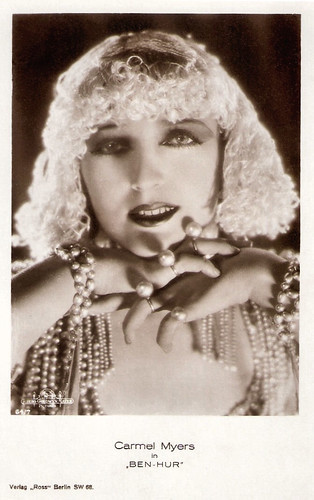
German postcard by Ross Verlag, Berlin, no. 64/7. Photo: Metro-Goldwyn-Mayer. Publicity still for Ben-Hur (Fred Niblo, 1925).
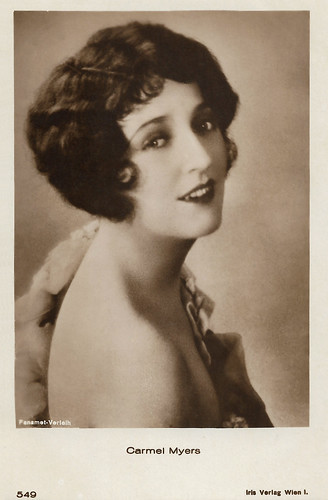
Austrian postcard by Iris-Verlag, no. 549. Photo: Fanamet-Verleih.
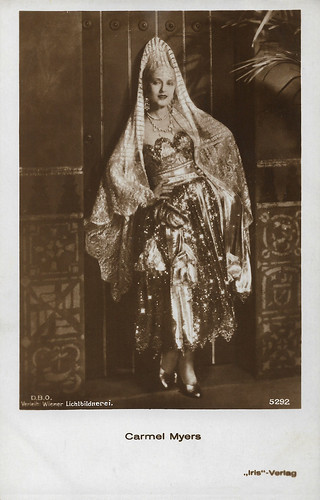
Austrian postcard by Iris-Verlag, no. 5292. Photo: D.B.O. / Wiener Lichtbildnerei. Publicity still for Prowlers of the Sea (John G. Adolfi, 1928).
The harem favourite in Babylon
Carmel Myers was born in San Francisco in 1899 as the daughter of an Australian rabbi and an Austrian Jewish mother.
Her father who had close contacts with the world of cinema, presented her to pioneer film director D.W. Griffith. The famous director entrusted the young novice actress with a small role in his blockbuster Intolerance (D.W. Griffith, 1916), where she played the harem favourite in the Babylonian episode.
Myers also managed to get Carmel's brother Zion to work in the film industry, becoming a Hollywood director and screenwriter.
After this experience, Carmel left New York where she had worked at the theatre for two years and signed a contract with Universal where she soon made herself known by playing vamp roles.
Of that period, probably her best-known film remains All Night (Paul Powell, 1918), where she acted alongside Rodolfo Valentino , then still little-known.
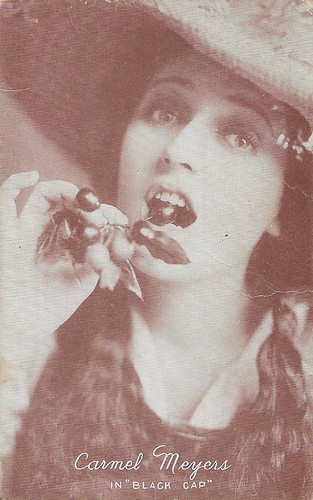
American postcard. Photo: Universal. Carmel Myers in A Daughter of the Law (Jack Conway, 1921), based on the novel 'The Black Cap' by Wadsworh Camp. This card uses the book title for the film title, so maybe the film was originally published with this title.
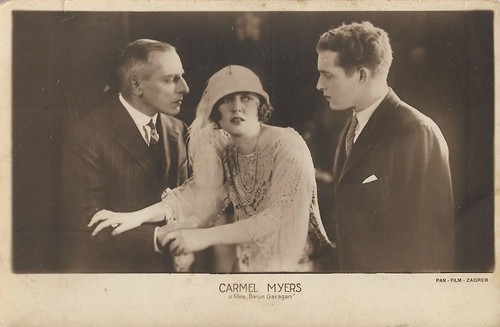
Croatian postcard. Photo: Pan-Film Zagreb. Carmel Myers in Garragan (Ludwig Wolff, 1924), starring Edward Burns and Myers. Ludwig Wolff also produced and scripted the film, while the script was based on a novel by Wolff himself. Garragan treats one of Wolff's favourite themes, that of reincarnation. Baron Garragan, who has been rightly condemned to ten years in prison for the murder on a man he believed to be his wife's lover, is released...
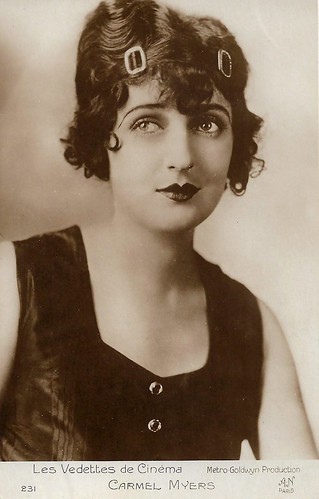
French postcard in the Les Vedettes de Cinéma series by A.N., Paris, no. 231. Photo: Metro-Goldwyn Production.
A formidable boost to her career
From 1924, Carmel Myers worked for MGM. While waiting for her shoots in Italy for the super-production Ben-Hur, started by director Charles Brabin and finished by his colleague Fred Niblo, took so long, she could act in the meantime in a German film in Berlin, Garragan (Ludwig Wolff, 1924), also with Edward Burns and Julanne Johnston.
However, it would be Myers's part in Ben-Hur: A Tale of the Christ (1925), which gave a formidable boost to her career. She played the role of Iras, an Egyptian courtesan who on the instigation of Messala (Francis X. Bushman) tries - in vain - to seduce Prince Judah Ben Hur ( Ramon Novarro ). The memorable POV shot of Iras eyeing Ben-Hur from bottom to top well shows classic Hollywood was not only about male gaze and female object.
From that moment on, Myers played major roles throughout the 1920s, sometimes in female leads as in The Careless Age (John Griffith Wray, 1929) with Douglas Fairbanks Jr., but mostly as the mundane and less chaste antagonist to the better behaving female leads such as Norma Shearer, Marceline Day, Anna Q. Nilsson , and Joan Crawford.
The advent of sound did not affect her career. She continued to act even though, due to her age, she saw herself entrusted with supporting roles. At the end of the Second World War, Myers retired from the scene for a few years.
She returned there in 1951, working for television. She also conducted a TV program called The Carmel Myers Show, but the series was unsuccessful. From then on, she devoted herself mainly to her real estate investments and to her perfume distribution company.
The last film she acted in was Won Ton Ton, The Dog That Saved Hollywood (Michael Winner, 1976), where she appeared along with dozens of Hollywood stars who took part in the film in small cameos.
Carmel Myers died in 1980, at the age of 81 and was buried at the Home of Peace Cemetery in Los Angeles next to her parents.
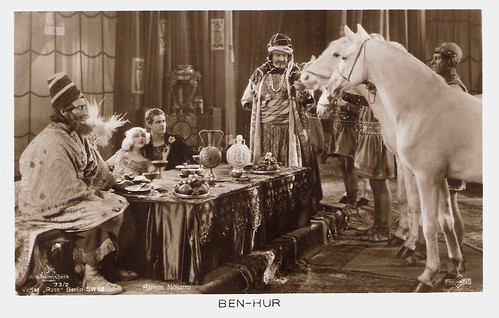
German postcard by Ross Verlag, no. 73/2. Photo: MGM / ParUfaMet. Ramon Novarro and Carmel Myers in Ben-Hur: A Tale of the Christ (Fred Niblo, 1925).
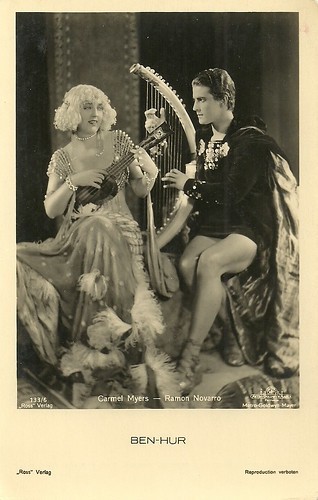
German postcard by Ross Verlag, no. 133/6. Photo: Metro-Goldwyn-Mayer. Carmel Myers and Ramon Novarro in Ben-Hur: A Tale of the Christ (Fred Niblo, 1925).
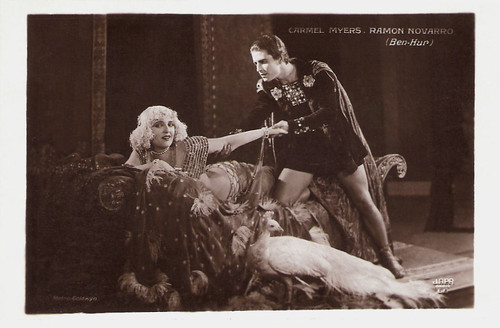
French postcard by J.R.P.R, Paris. no. 69. Photo: MGM. Carmel Myers and Ramon Novarro in Ben-Hur: A Tale of the Christ (Fred Niblo, 1925).
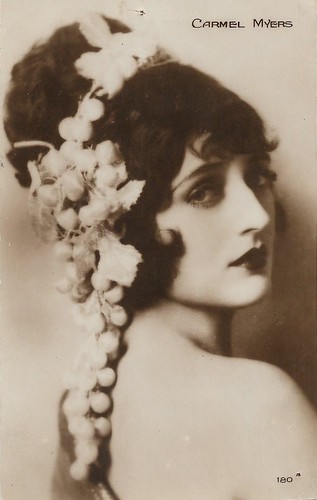
French postcard by Editions Cinémagazine, no. 180.
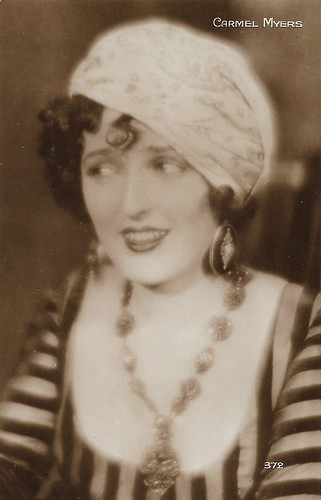
French postcard by Editions Cinémagazine, no. 372.
Sources: Wikipedia and .

German postcard by Ross Verlag, Berlin, no. 64/7. Photo: Metro-Goldwyn-Mayer. Publicity still for Ben-Hur (Fred Niblo, 1925).

Austrian postcard by Iris-Verlag, no. 549. Photo: Fanamet-Verleih.

Austrian postcard by Iris-Verlag, no. 5292. Photo: D.B.O. / Wiener Lichtbildnerei. Publicity still for Prowlers of the Sea (John G. Adolfi, 1928).
The harem favourite in Babylon
Carmel Myers was born in San Francisco in 1899 as the daughter of an Australian rabbi and an Austrian Jewish mother.
Her father who had close contacts with the world of cinema, presented her to pioneer film director D.W. Griffith. The famous director entrusted the young novice actress with a small role in his blockbuster Intolerance (D.W. Griffith, 1916), where she played the harem favourite in the Babylonian episode.
Myers also managed to get Carmel's brother Zion to work in the film industry, becoming a Hollywood director and screenwriter.
After this experience, Carmel left New York where she had worked at the theatre for two years and signed a contract with Universal where she soon made herself known by playing vamp roles.
Of that period, probably her best-known film remains All Night (Paul Powell, 1918), where she acted alongside Rodolfo Valentino , then still little-known.

American postcard. Photo: Universal. Carmel Myers in A Daughter of the Law (Jack Conway, 1921), based on the novel 'The Black Cap' by Wadsworh Camp. This card uses the book title for the film title, so maybe the film was originally published with this title.

Croatian postcard. Photo: Pan-Film Zagreb. Carmel Myers in Garragan (Ludwig Wolff, 1924), starring Edward Burns and Myers. Ludwig Wolff also produced and scripted the film, while the script was based on a novel by Wolff himself. Garragan treats one of Wolff's favourite themes, that of reincarnation. Baron Garragan, who has been rightly condemned to ten years in prison for the murder on a man he believed to be his wife's lover, is released...

French postcard in the Les Vedettes de Cinéma series by A.N., Paris, no. 231. Photo: Metro-Goldwyn Production.
A formidable boost to her career
From 1924, Carmel Myers worked for MGM. While waiting for her shoots in Italy for the super-production Ben-Hur, started by director Charles Brabin and finished by his colleague Fred Niblo, took so long, she could act in the meantime in a German film in Berlin, Garragan (Ludwig Wolff, 1924), also with Edward Burns and Julanne Johnston.
However, it would be Myers's part in Ben-Hur: A Tale of the Christ (1925), which gave a formidable boost to her career. She played the role of Iras, an Egyptian courtesan who on the instigation of Messala (Francis X. Bushman) tries - in vain - to seduce Prince Judah Ben Hur ( Ramon Novarro ). The memorable POV shot of Iras eyeing Ben-Hur from bottom to top well shows classic Hollywood was not only about male gaze and female object.
From that moment on, Myers played major roles throughout the 1920s, sometimes in female leads as in The Careless Age (John Griffith Wray, 1929) with Douglas Fairbanks Jr., but mostly as the mundane and less chaste antagonist to the better behaving female leads such as Norma Shearer, Marceline Day, Anna Q. Nilsson , and Joan Crawford.
The advent of sound did not affect her career. She continued to act even though, due to her age, she saw herself entrusted with supporting roles. At the end of the Second World War, Myers retired from the scene for a few years.
She returned there in 1951, working for television. She also conducted a TV program called The Carmel Myers Show, but the series was unsuccessful. From then on, she devoted herself mainly to her real estate investments and to her perfume distribution company.
The last film she acted in was Won Ton Ton, The Dog That Saved Hollywood (Michael Winner, 1976), where she appeared along with dozens of Hollywood stars who took part in the film in small cameos.
Carmel Myers died in 1980, at the age of 81 and was buried at the Home of Peace Cemetery in Los Angeles next to her parents.

German postcard by Ross Verlag, no. 73/2. Photo: MGM / ParUfaMet. Ramon Novarro and Carmel Myers in Ben-Hur: A Tale of the Christ (Fred Niblo, 1925).

German postcard by Ross Verlag, no. 133/6. Photo: Metro-Goldwyn-Mayer. Carmel Myers and Ramon Novarro in Ben-Hur: A Tale of the Christ (Fred Niblo, 1925).

French postcard by J.R.P.R, Paris. no. 69. Photo: MGM. Carmel Myers and Ramon Novarro in Ben-Hur: A Tale of the Christ (Fred Niblo, 1925).

French postcard by Editions Cinémagazine, no. 180.

French postcard by Editions Cinémagazine, no. 372.
Sources: Wikipedia and .
Published on September 14, 2019 22:00
Paul van Yperen's Blog
- Paul van Yperen's profile
- 13 followers
Paul van Yperen isn't a Goodreads Author
(yet),
but they
do have a blog,
so here are some recent posts imported from
their feed.



